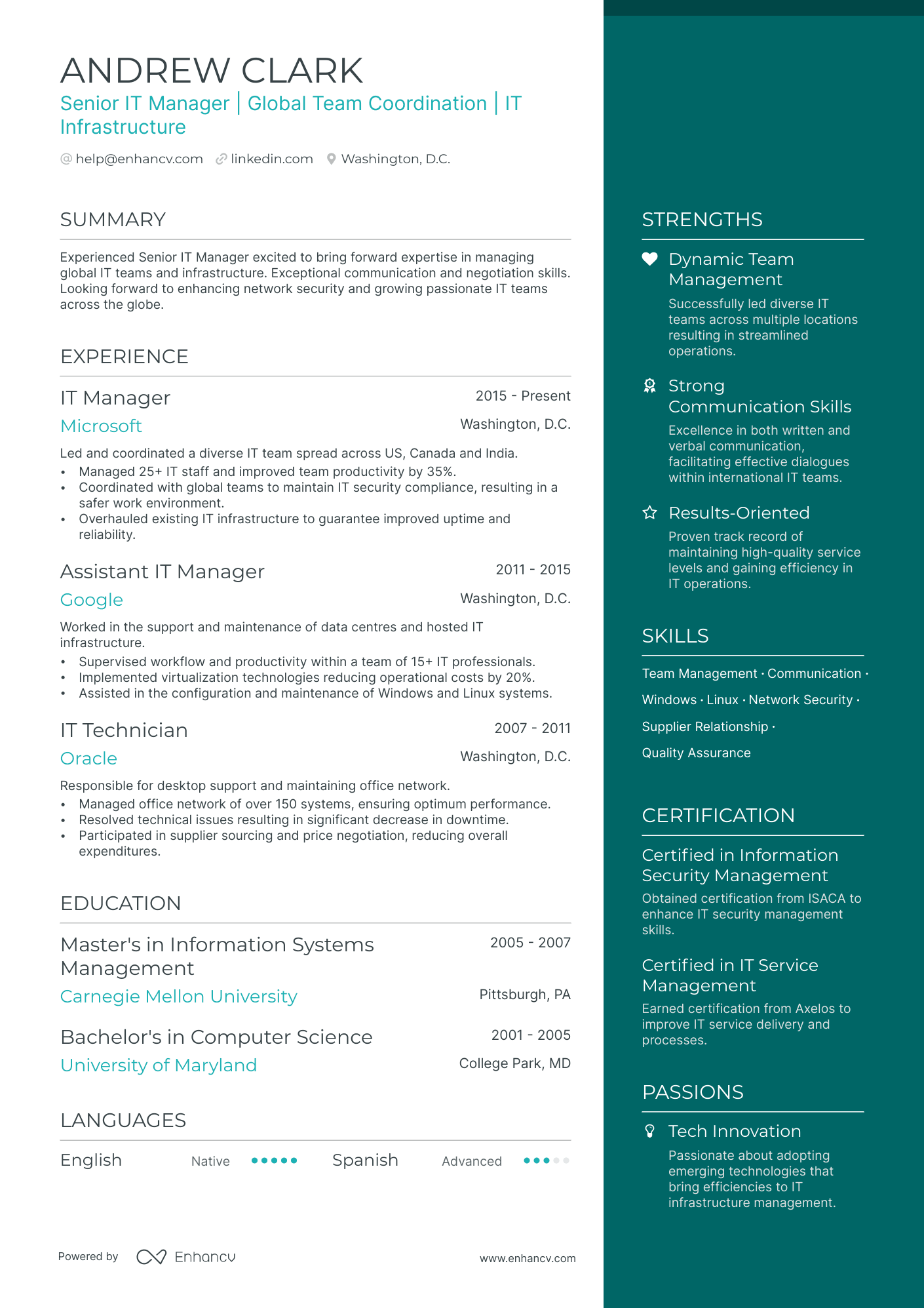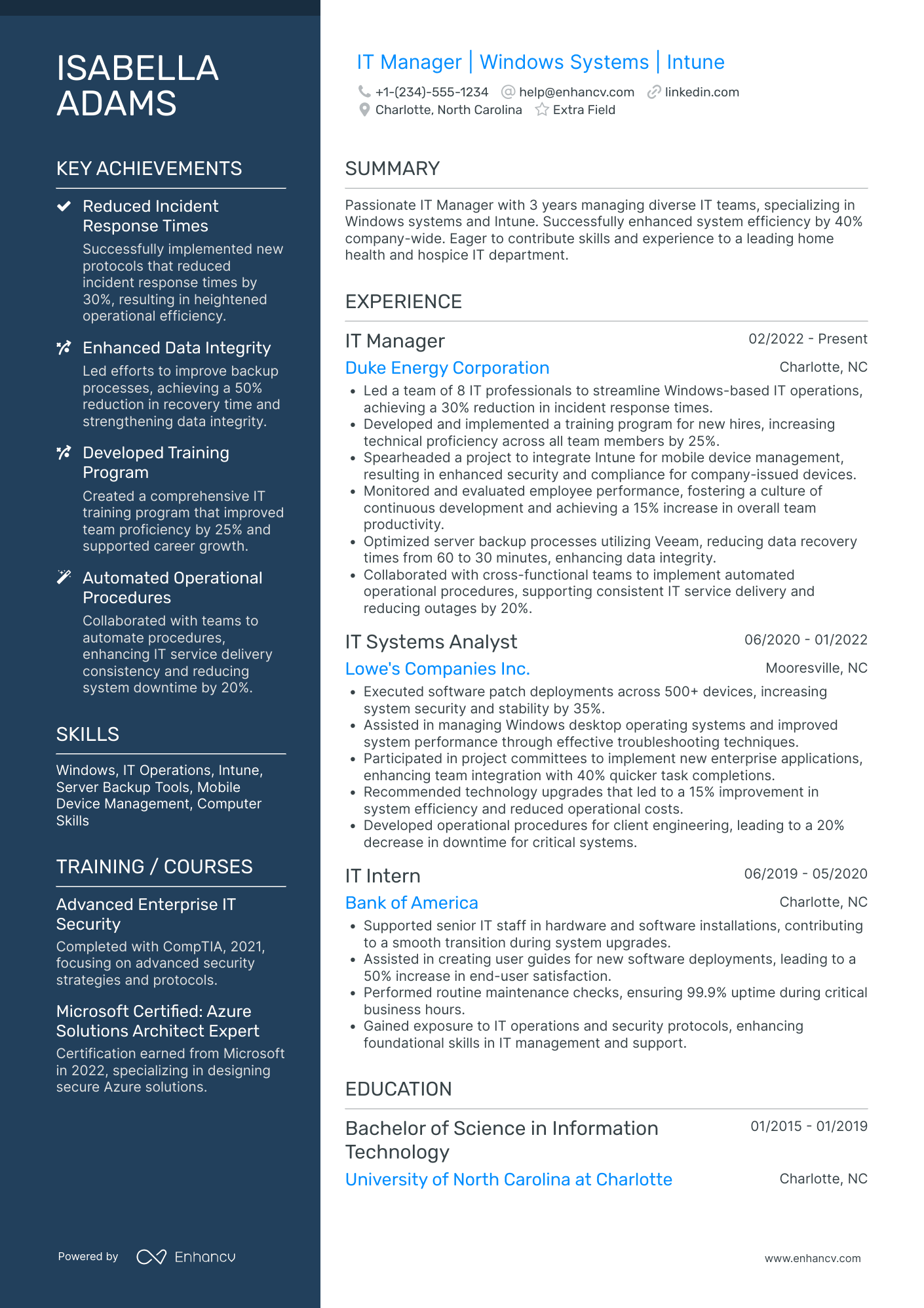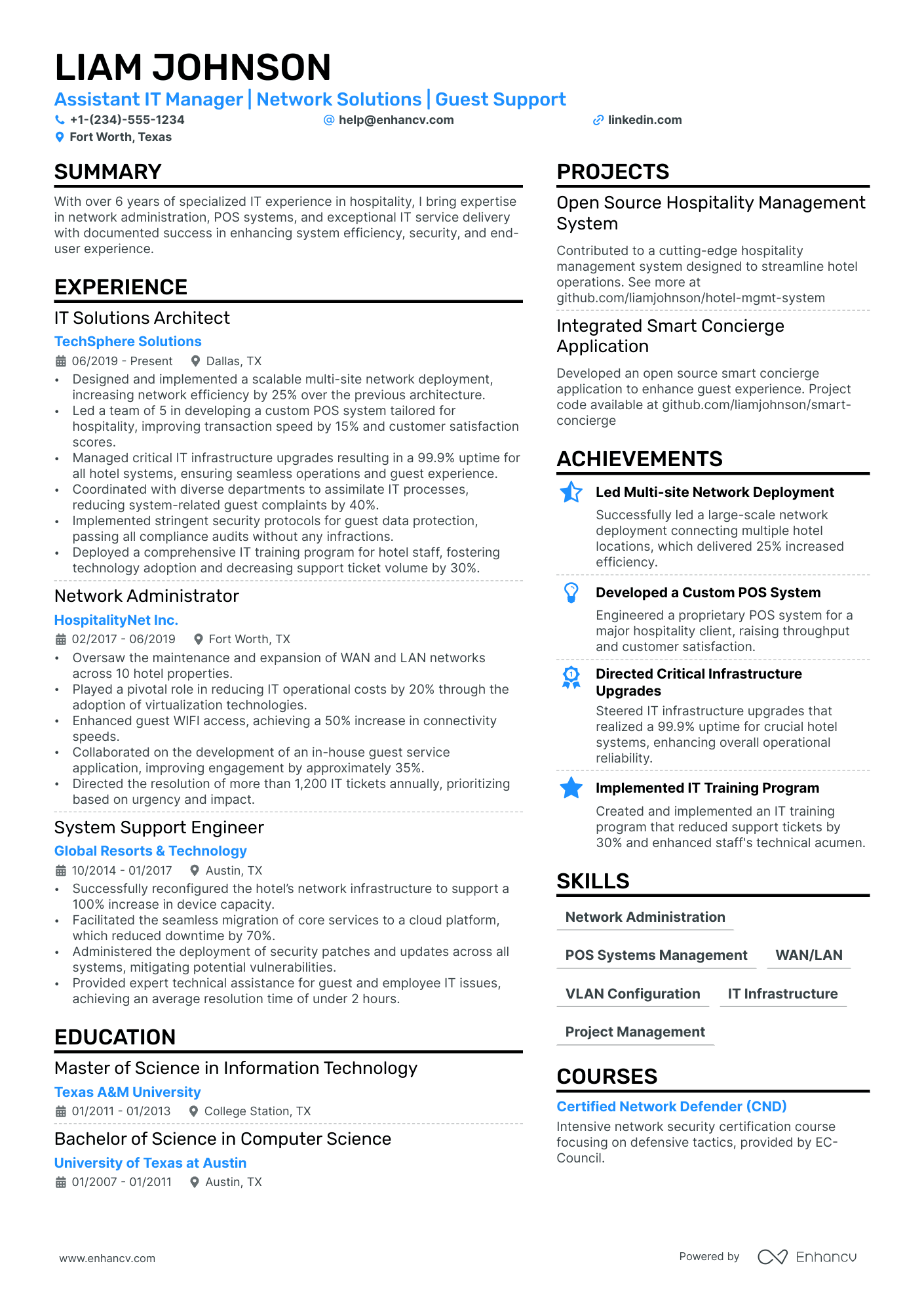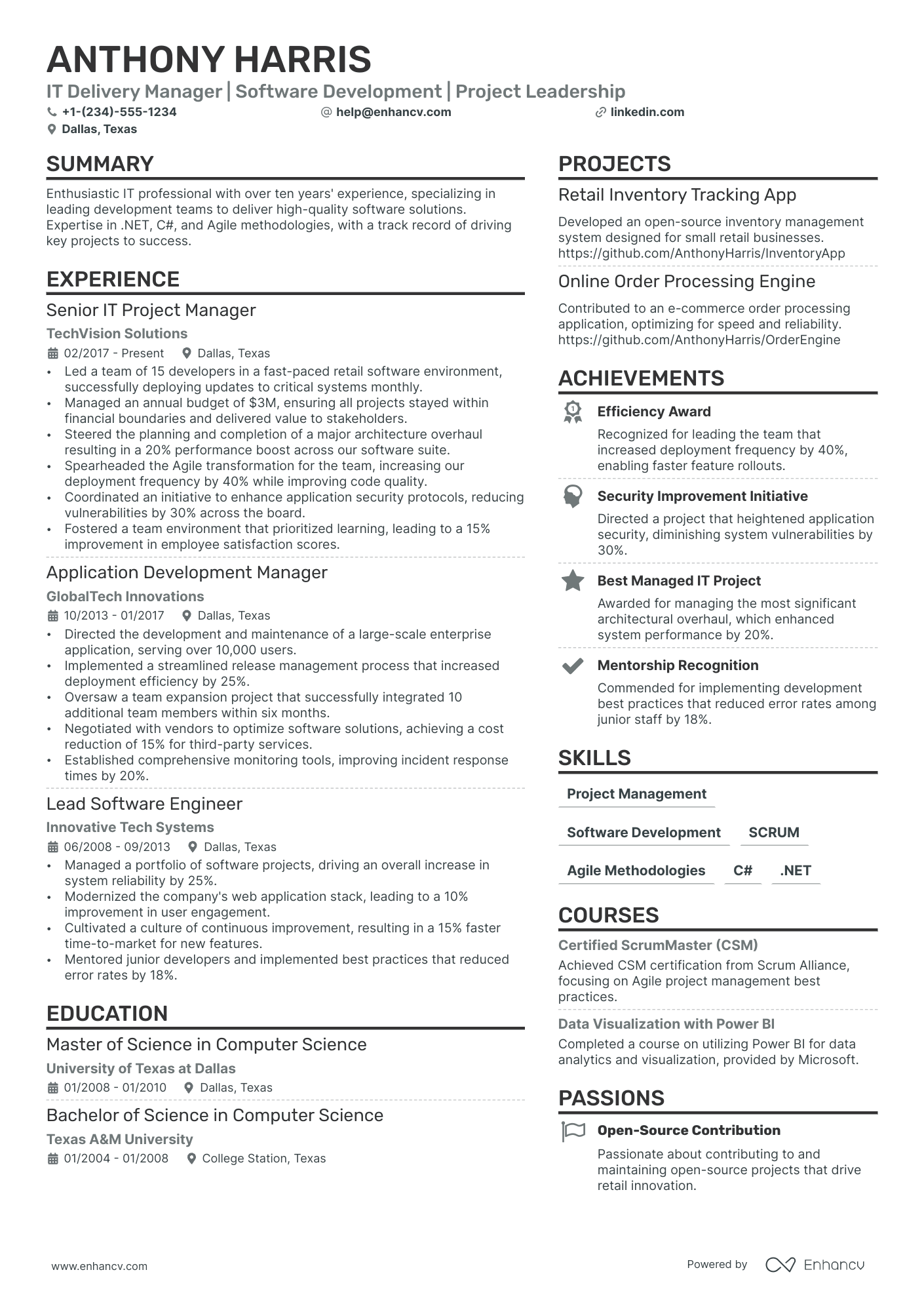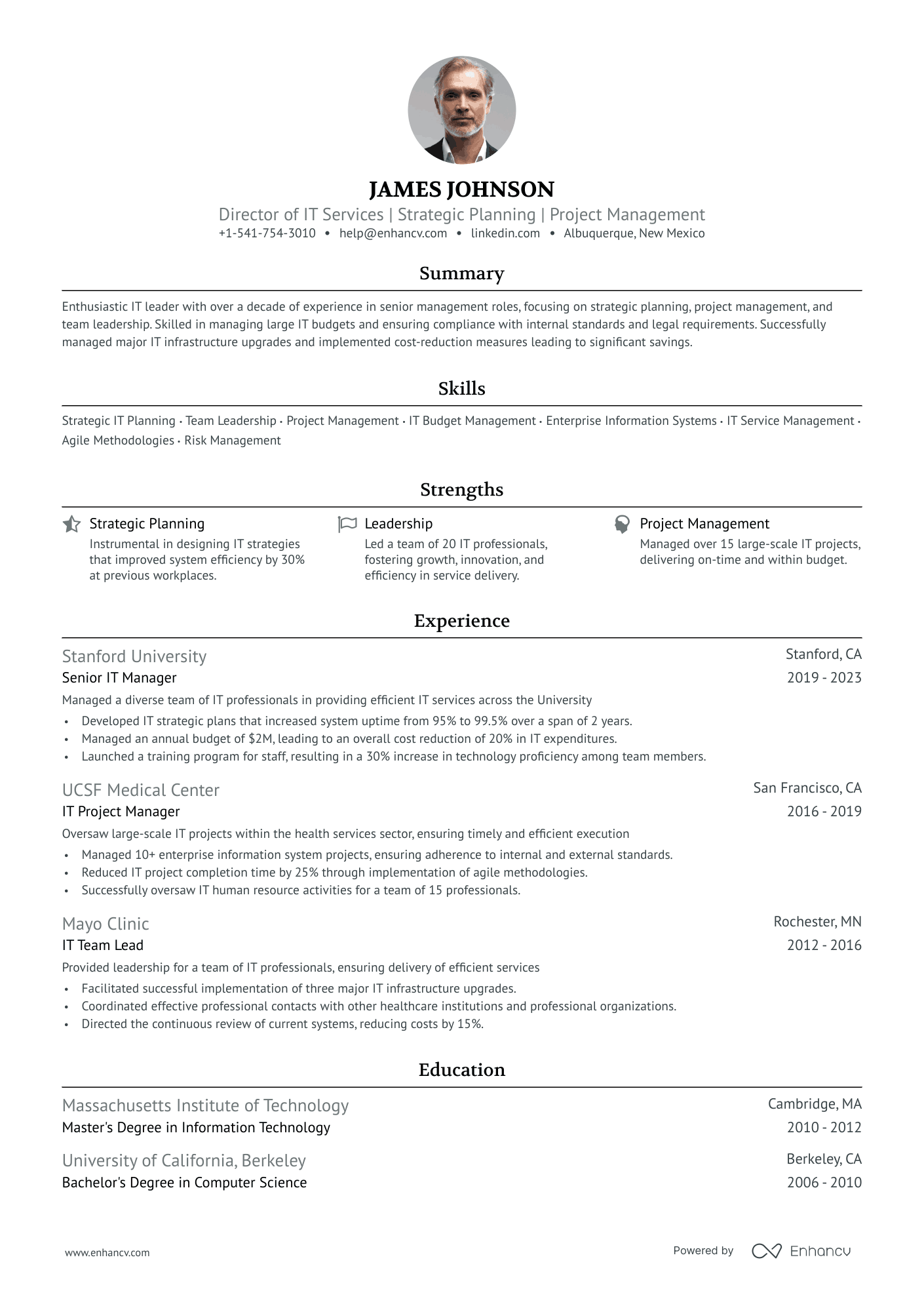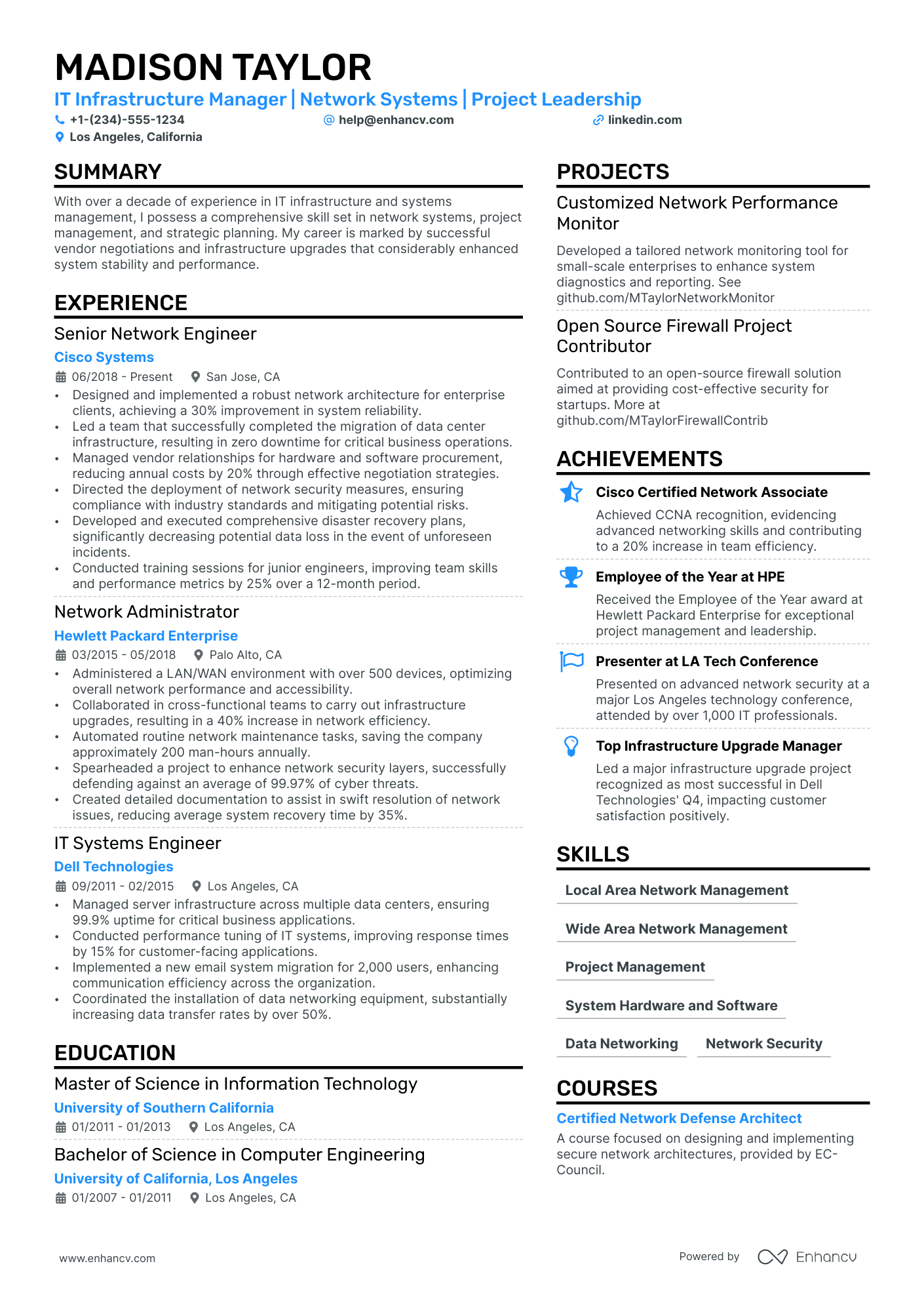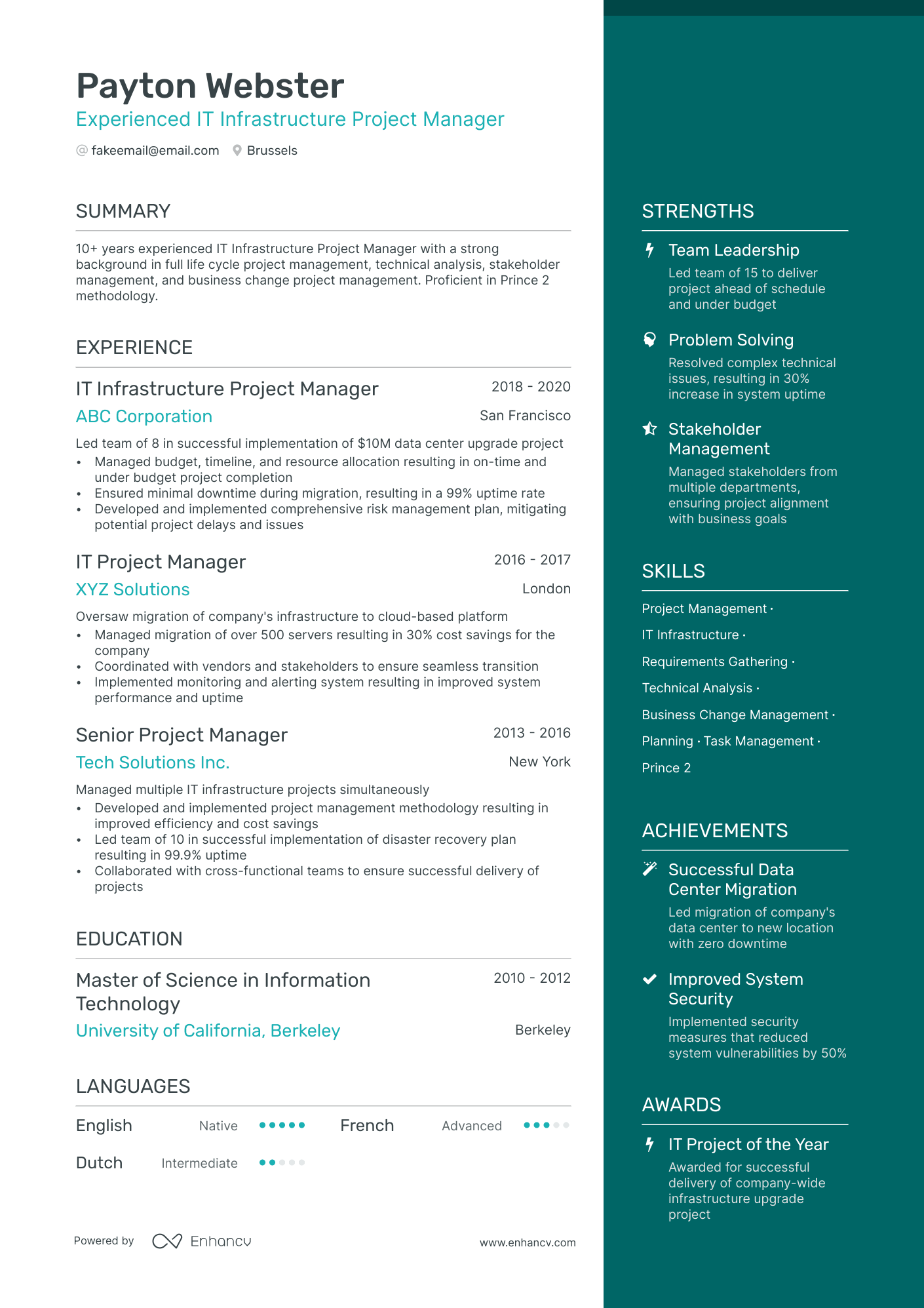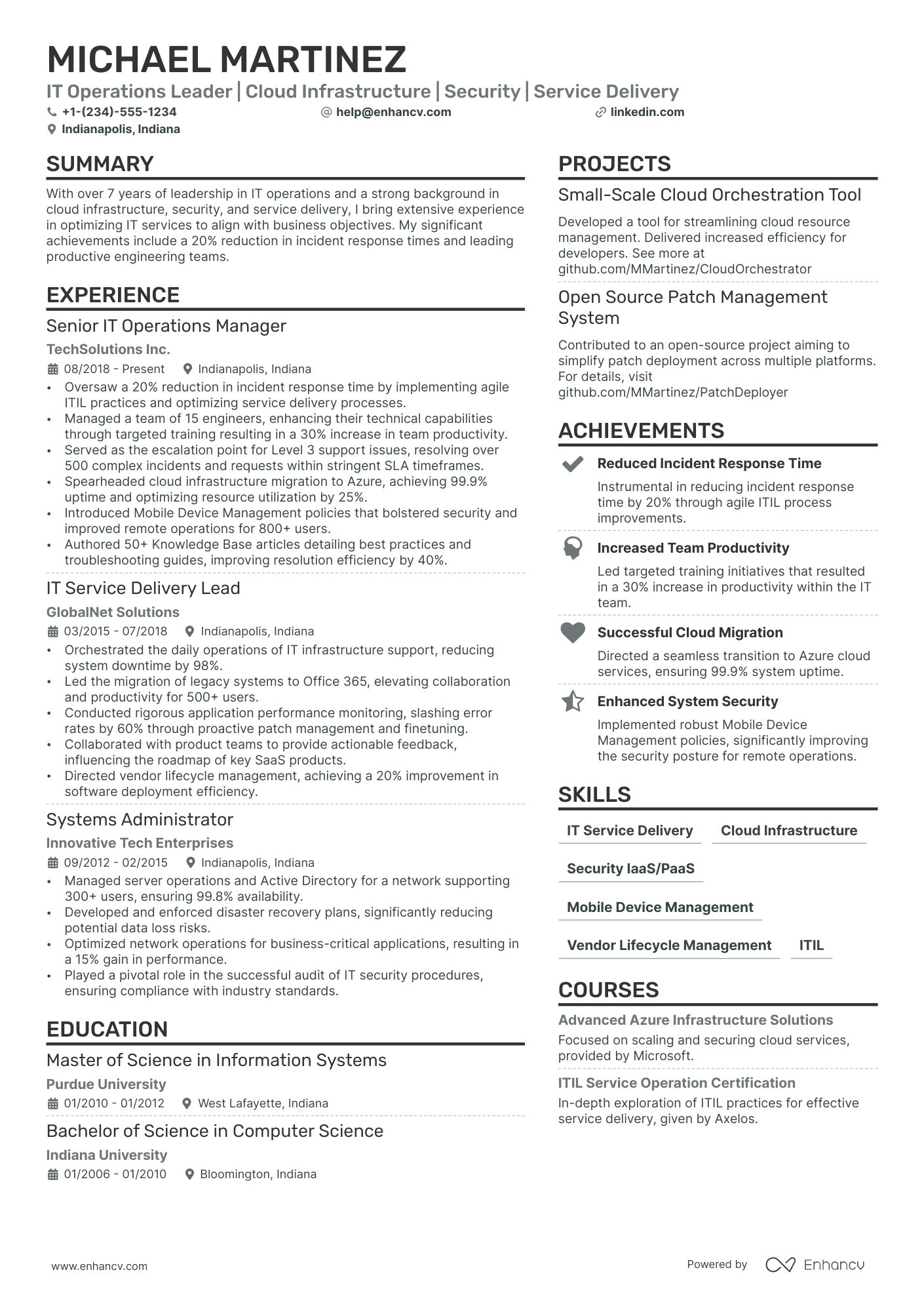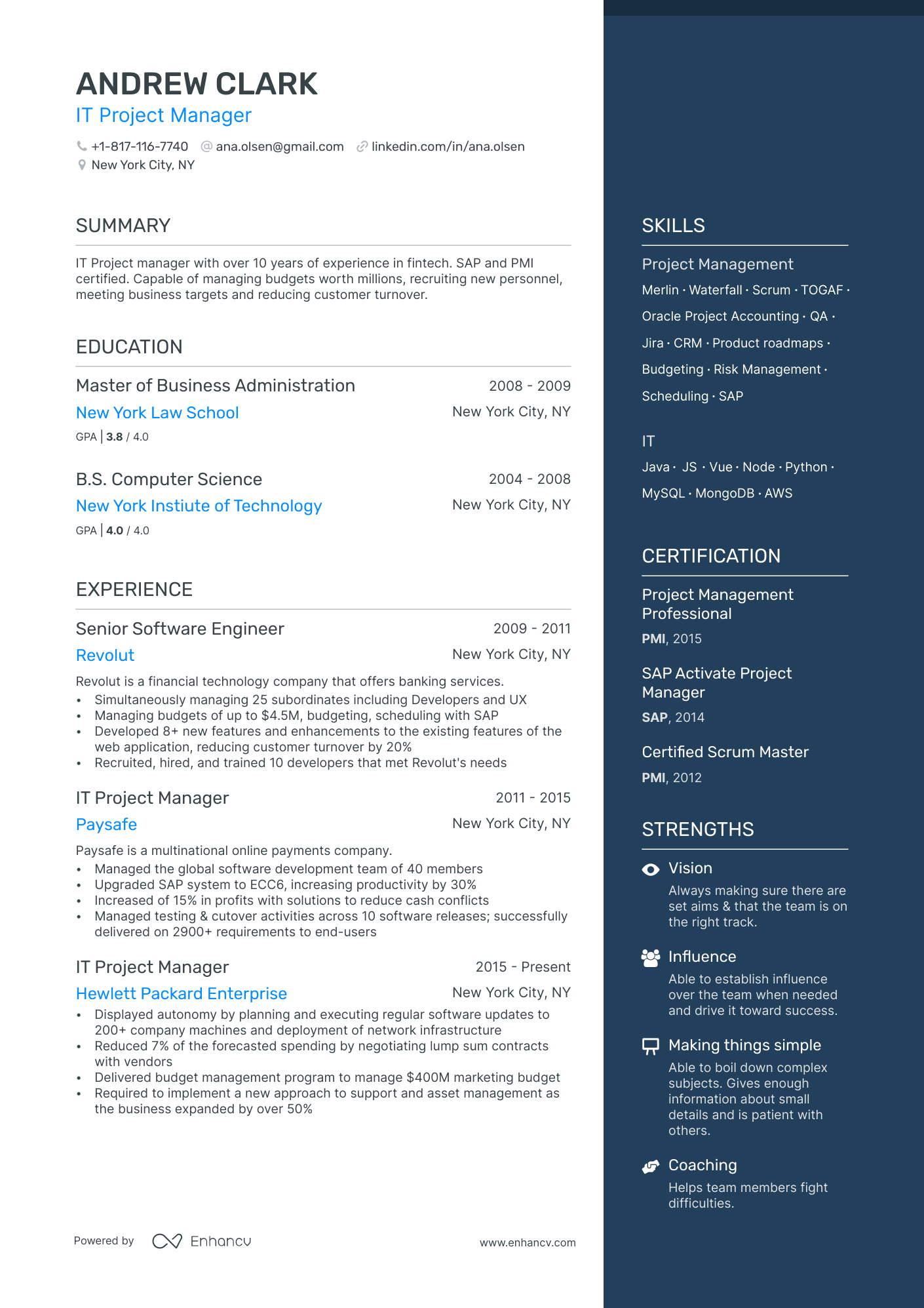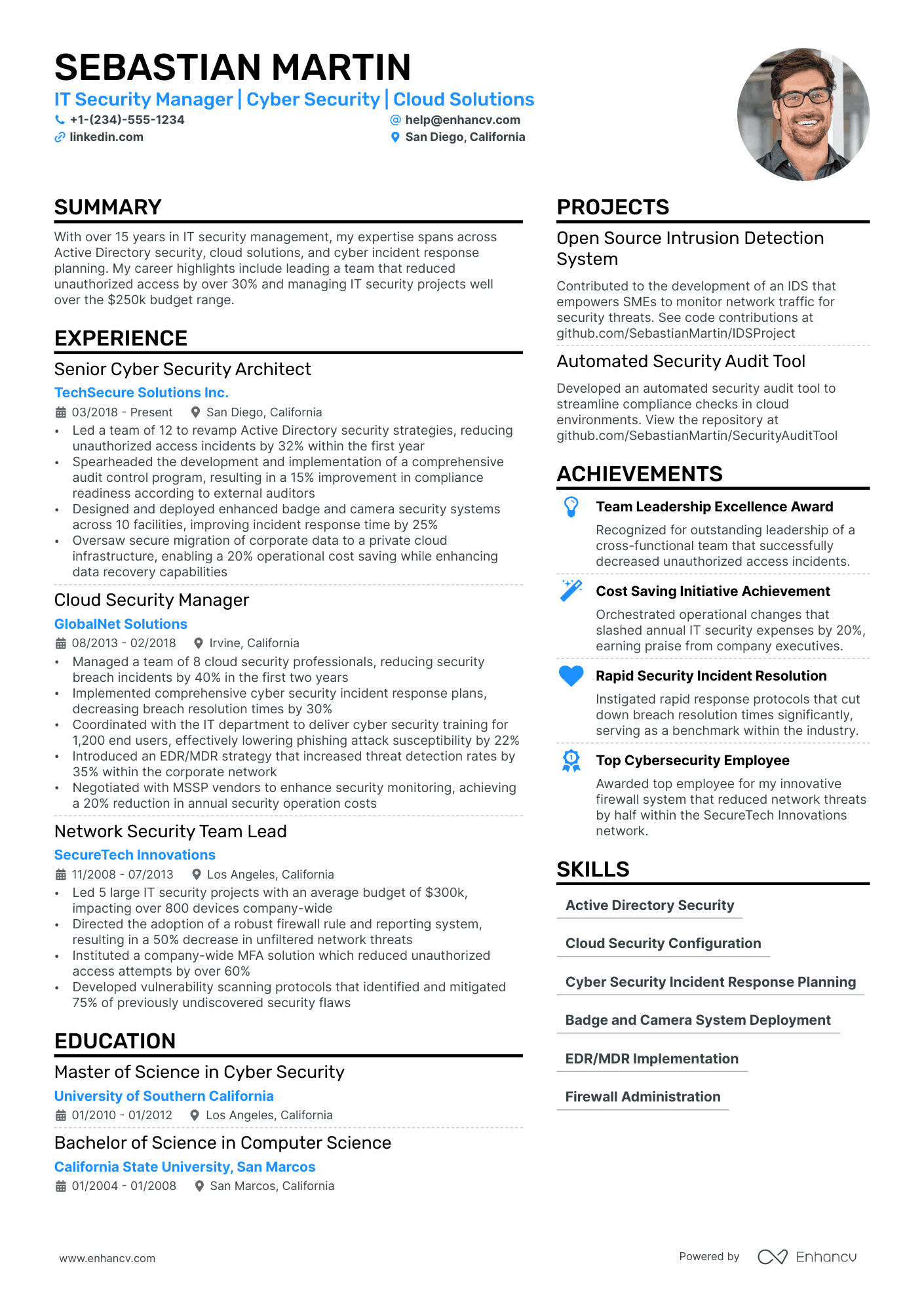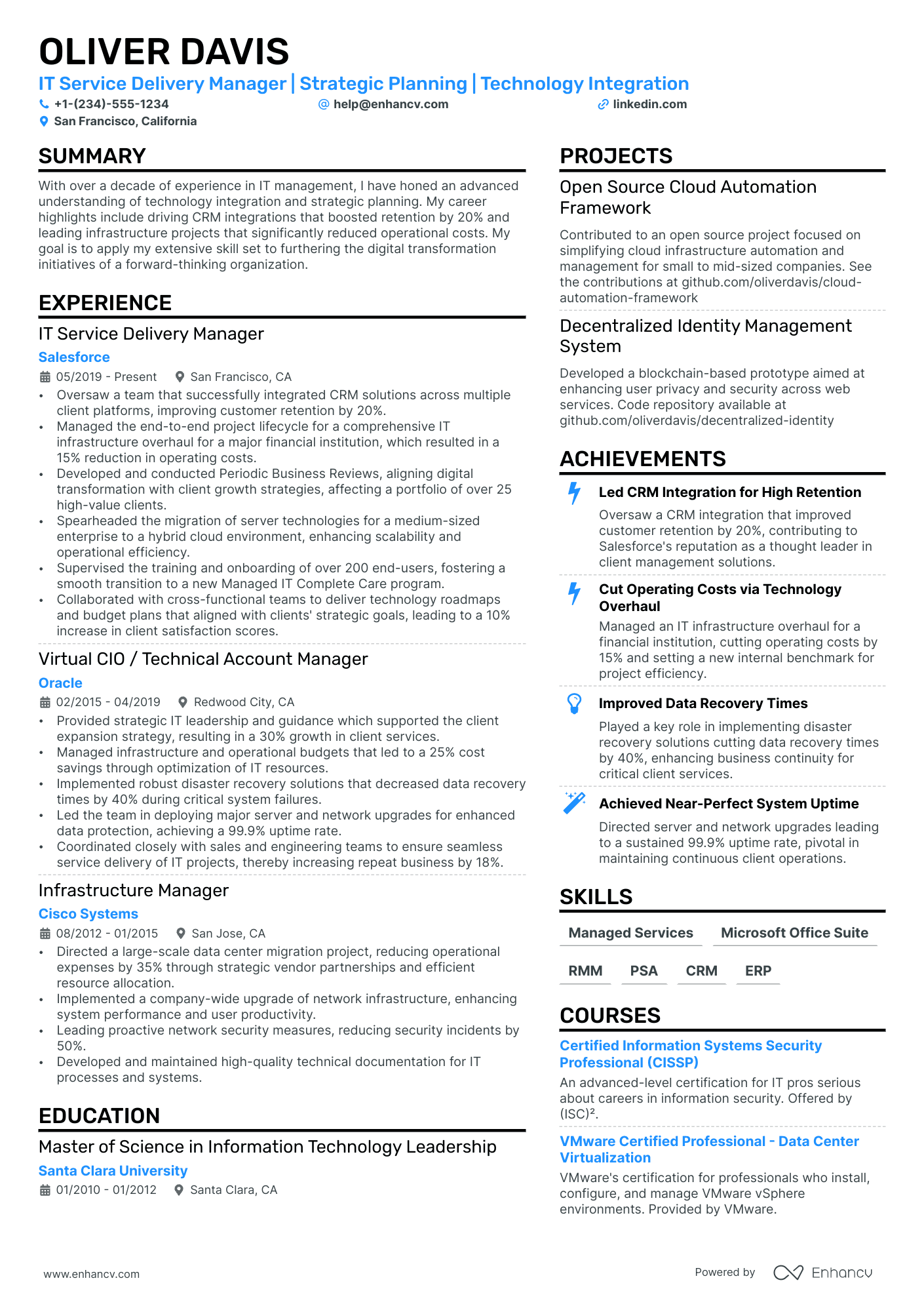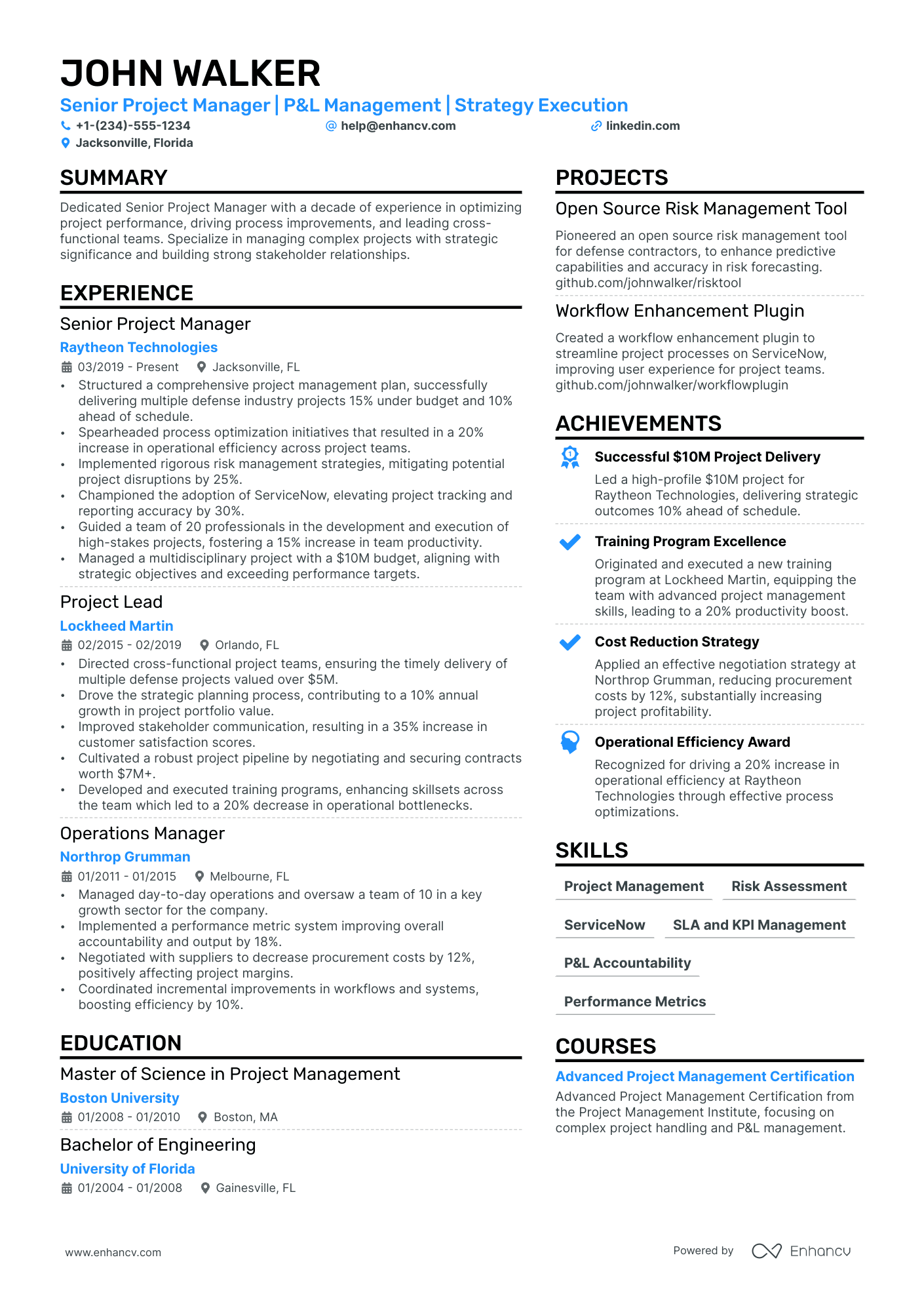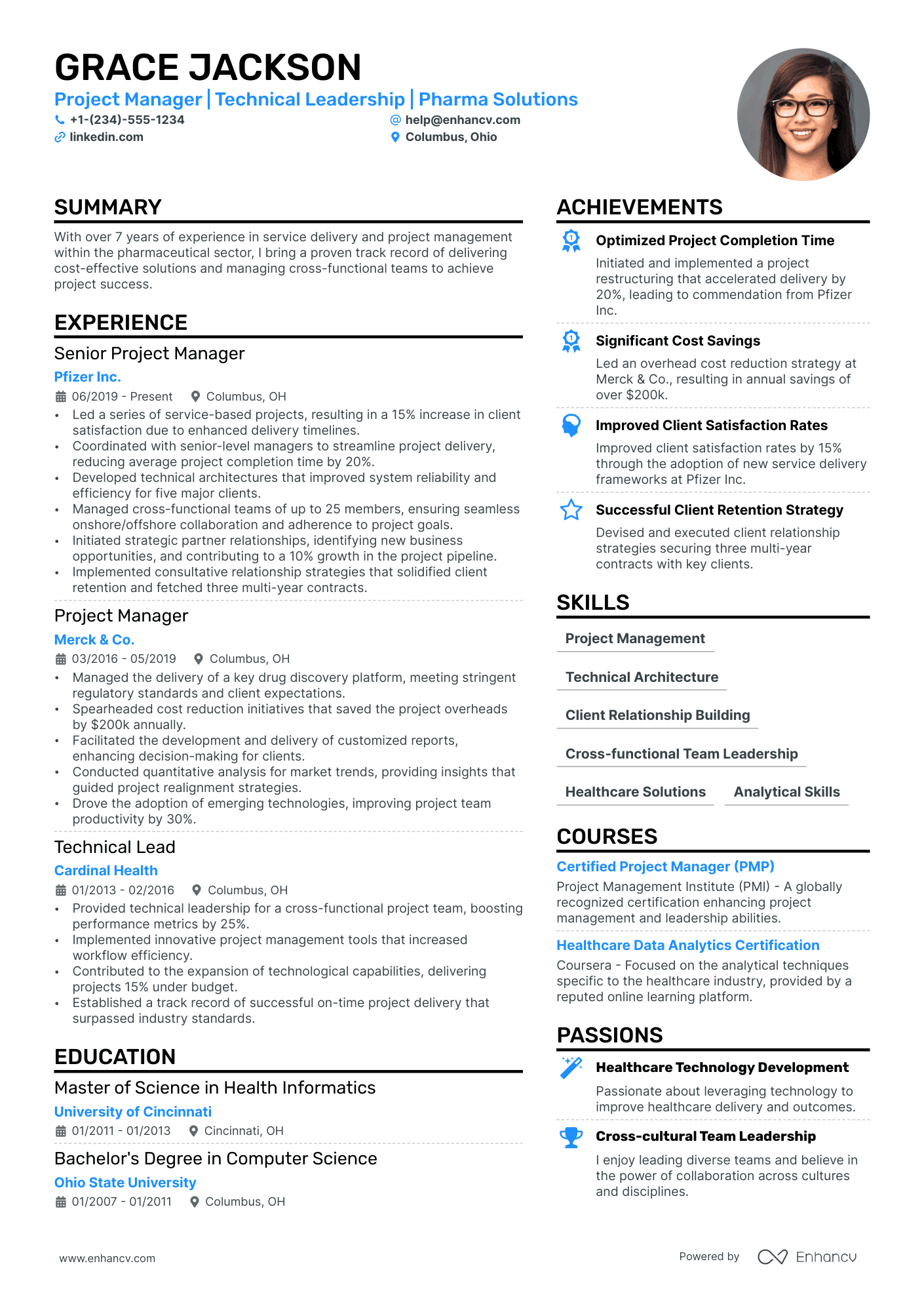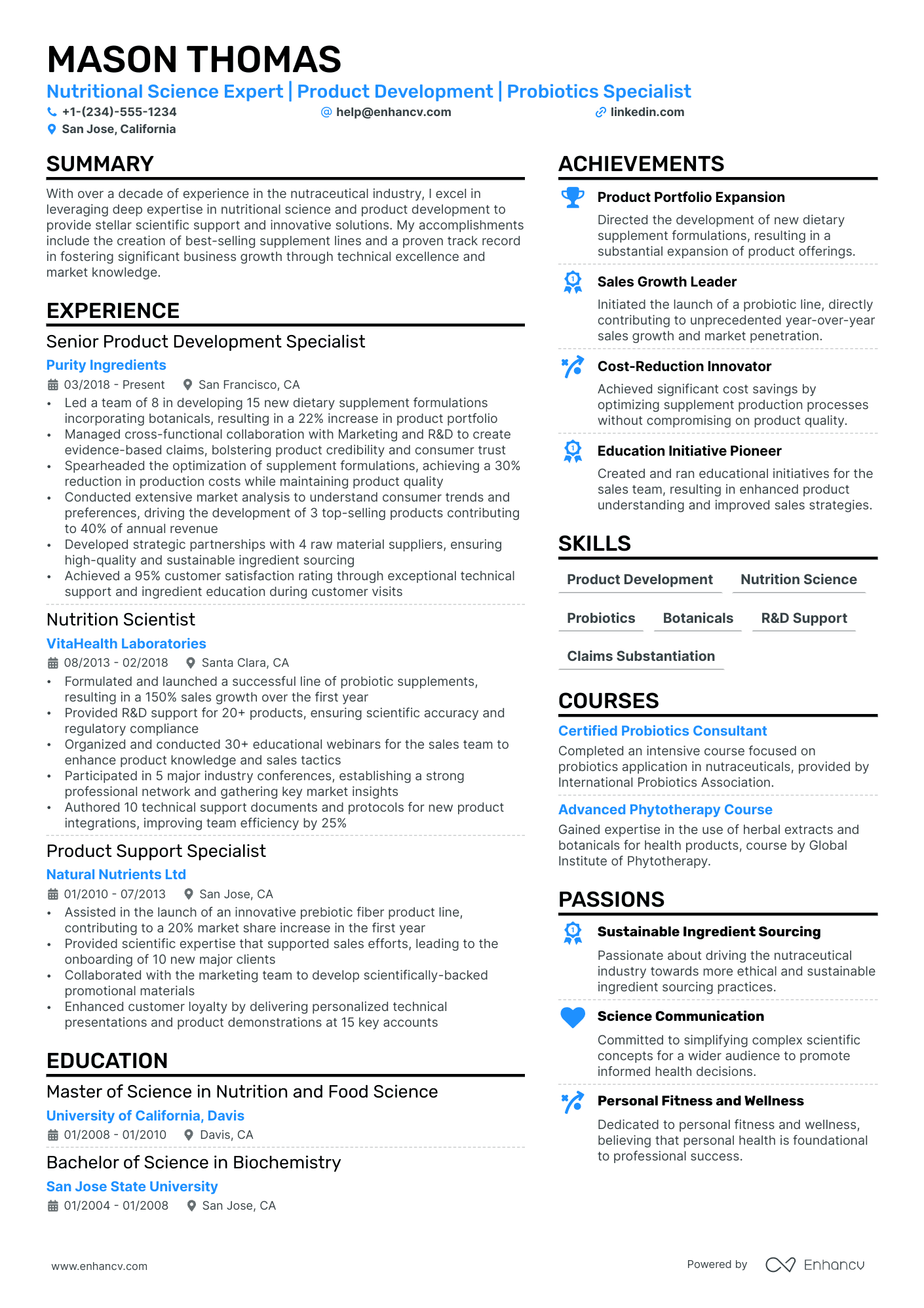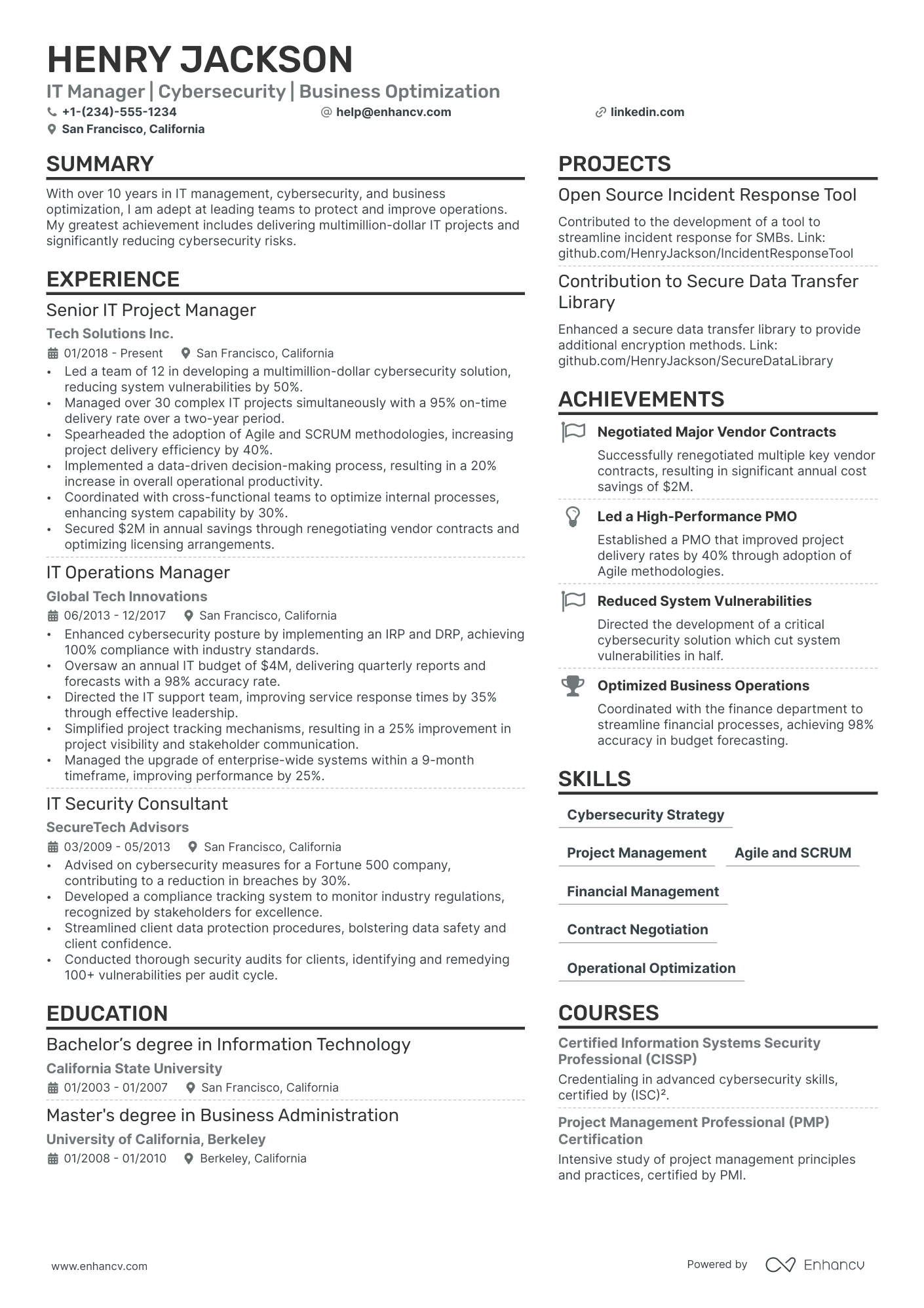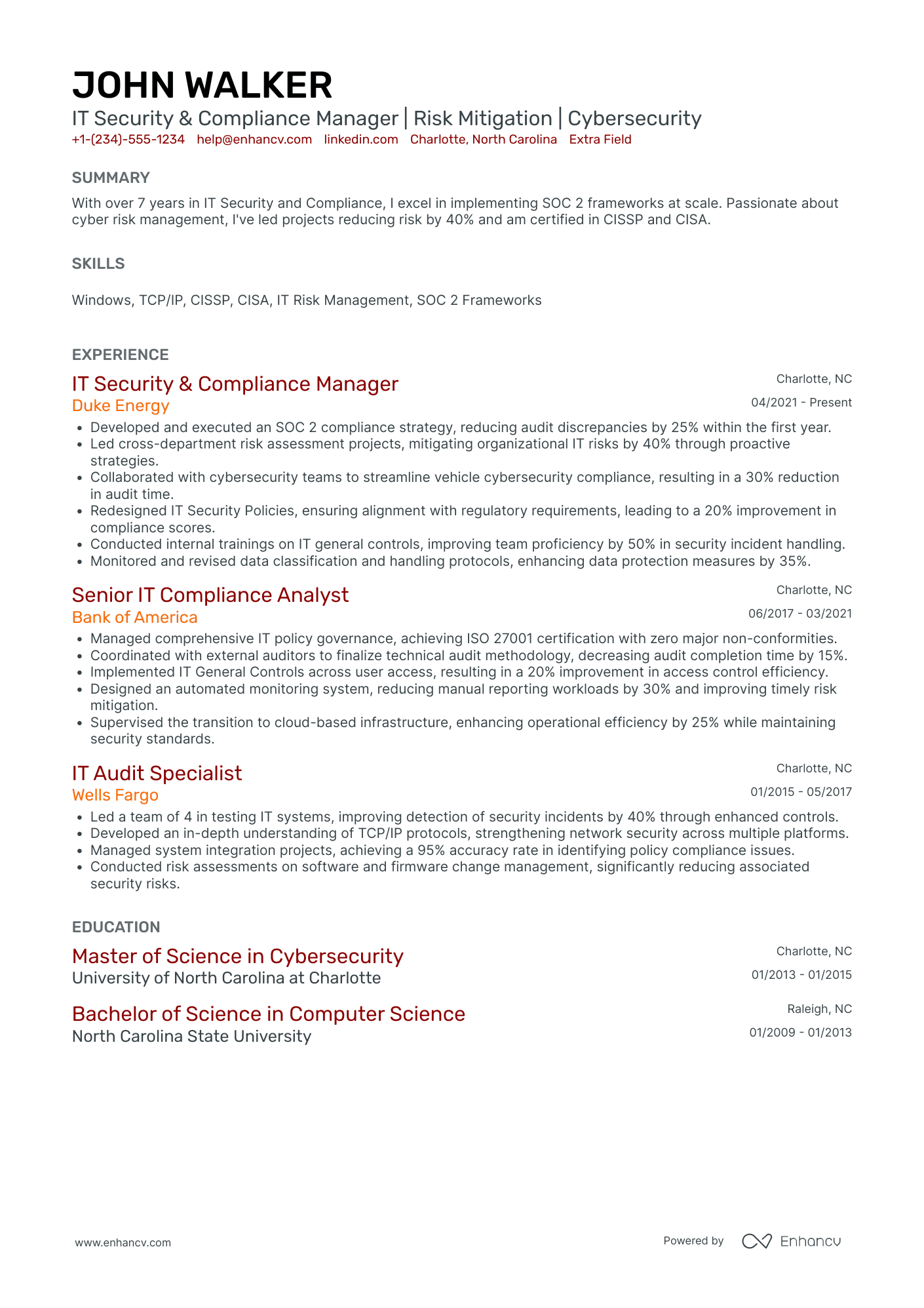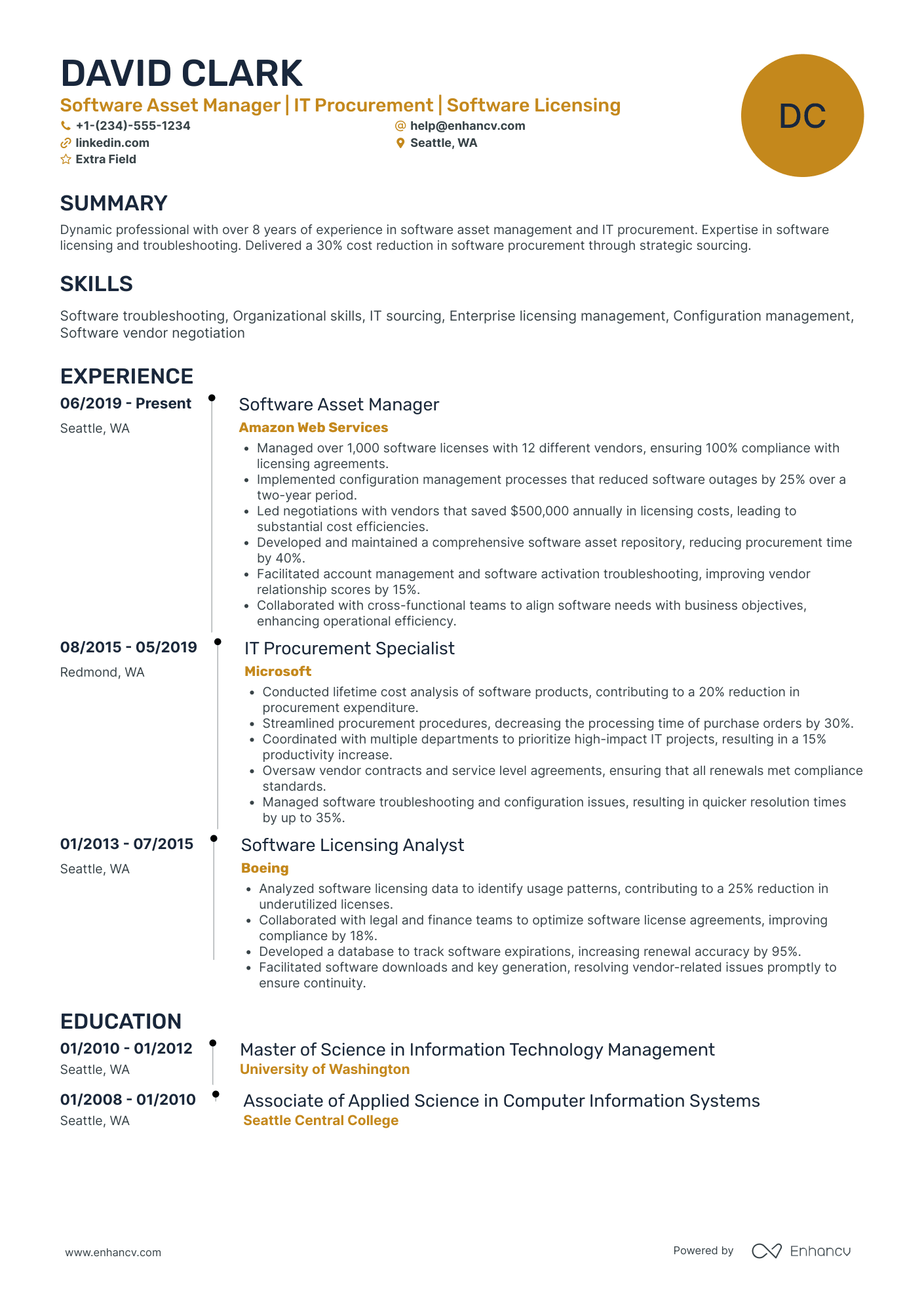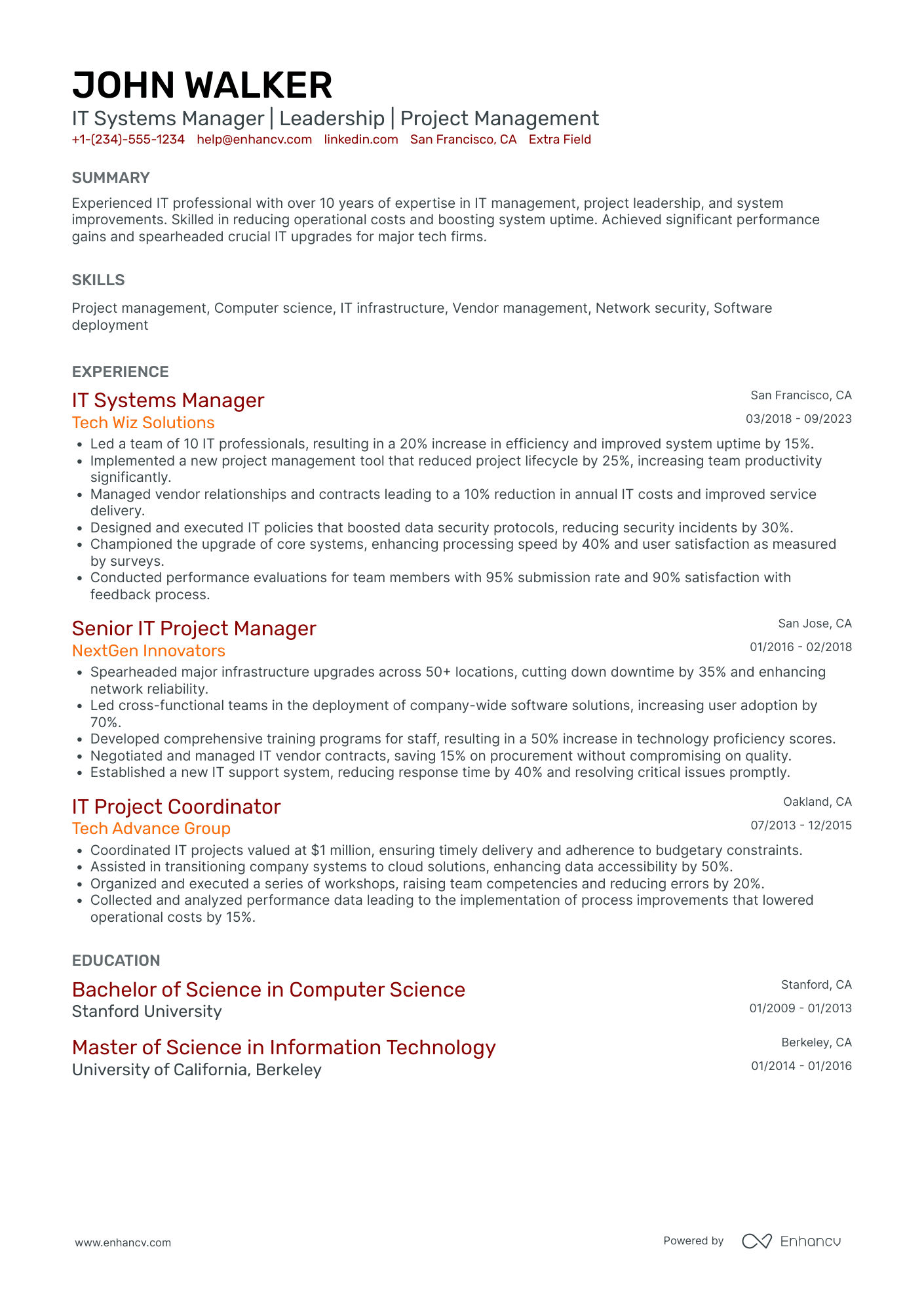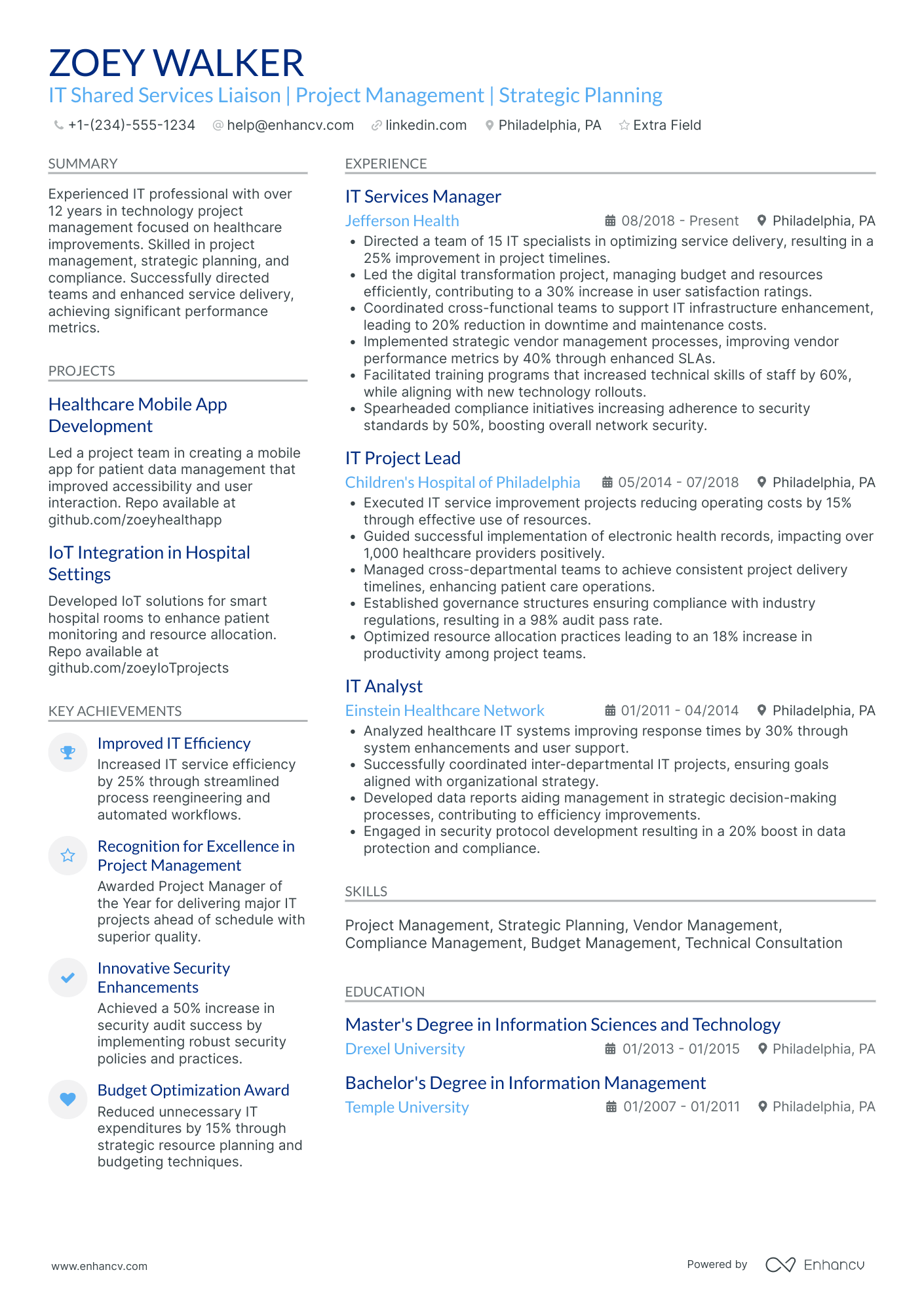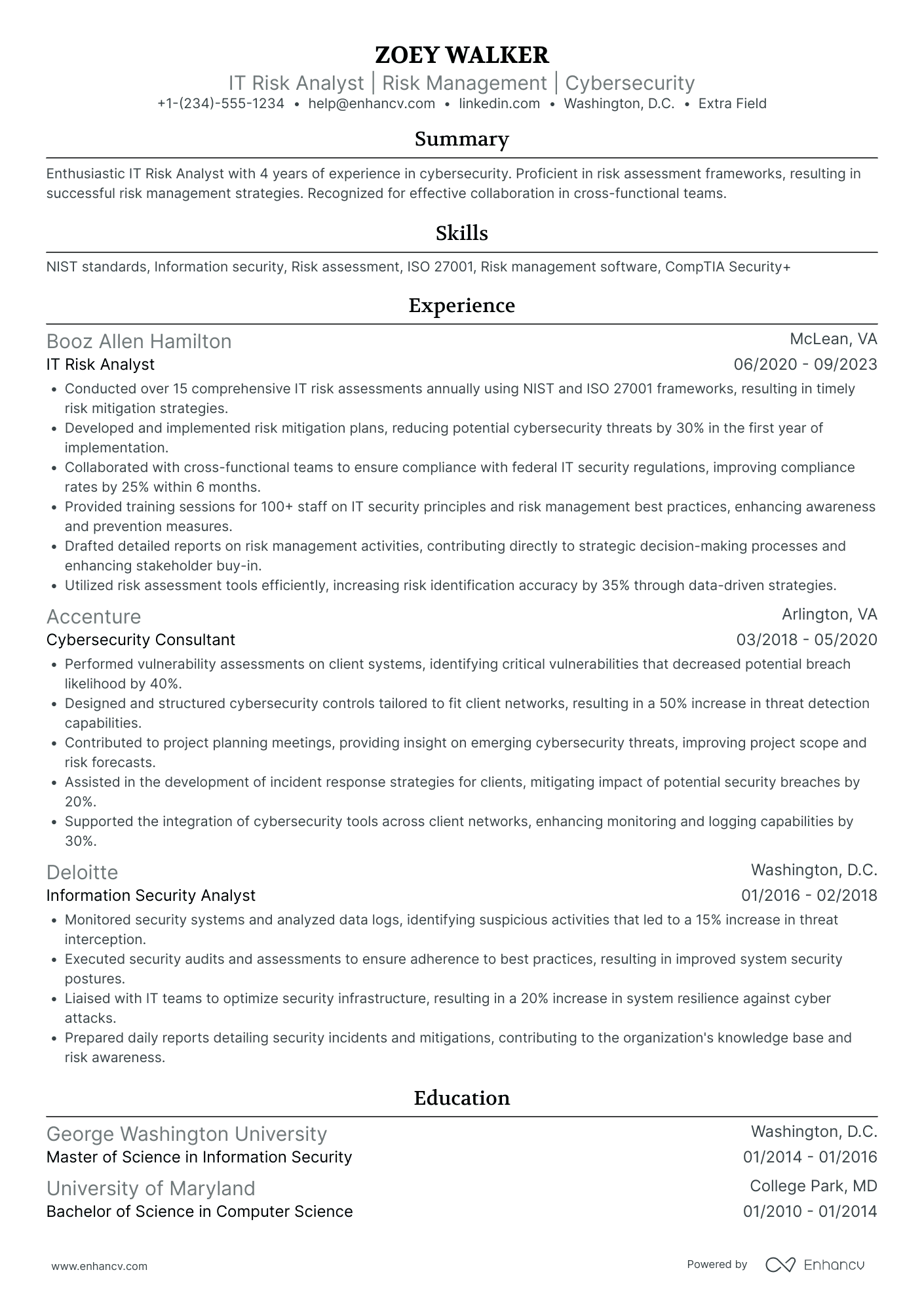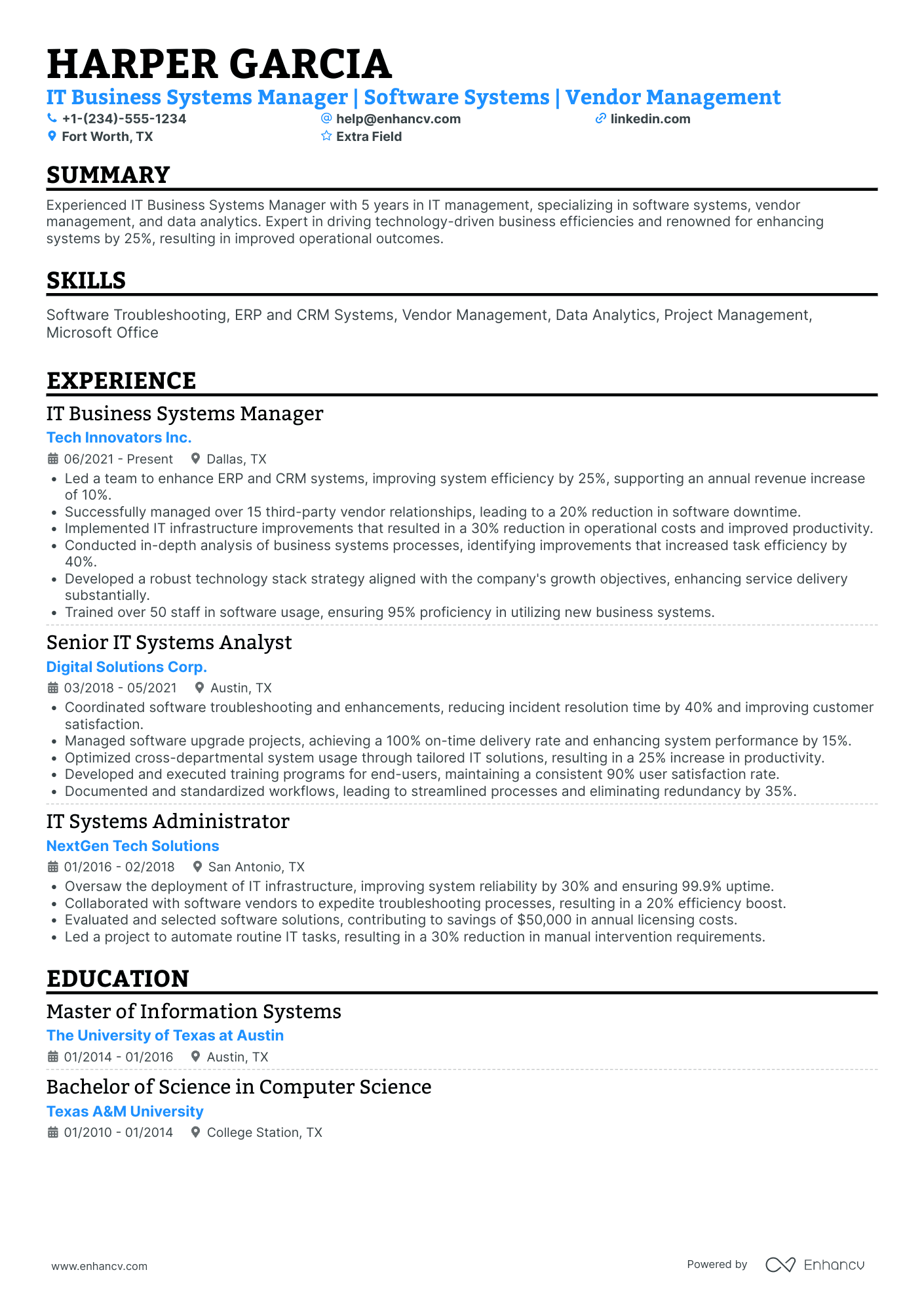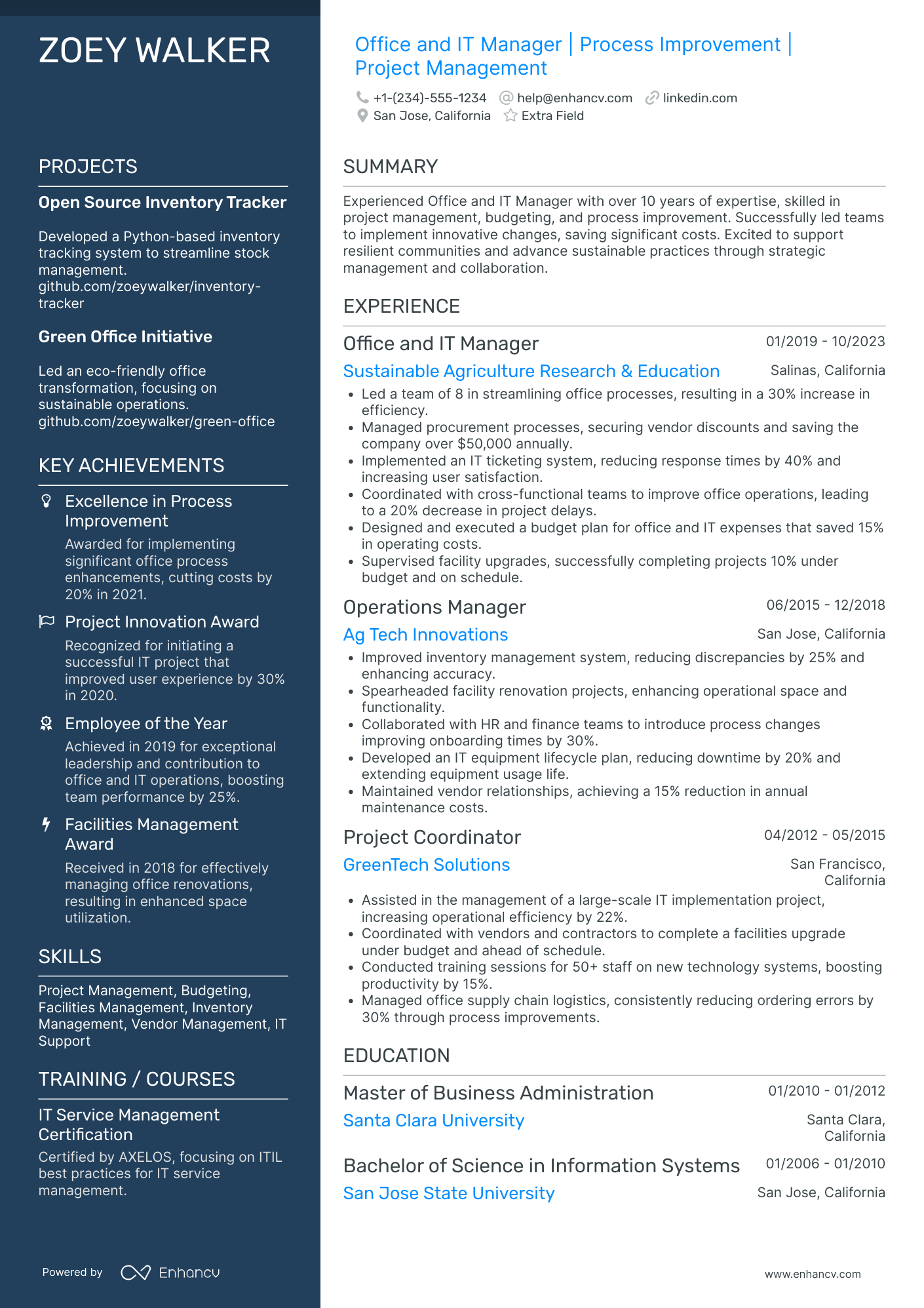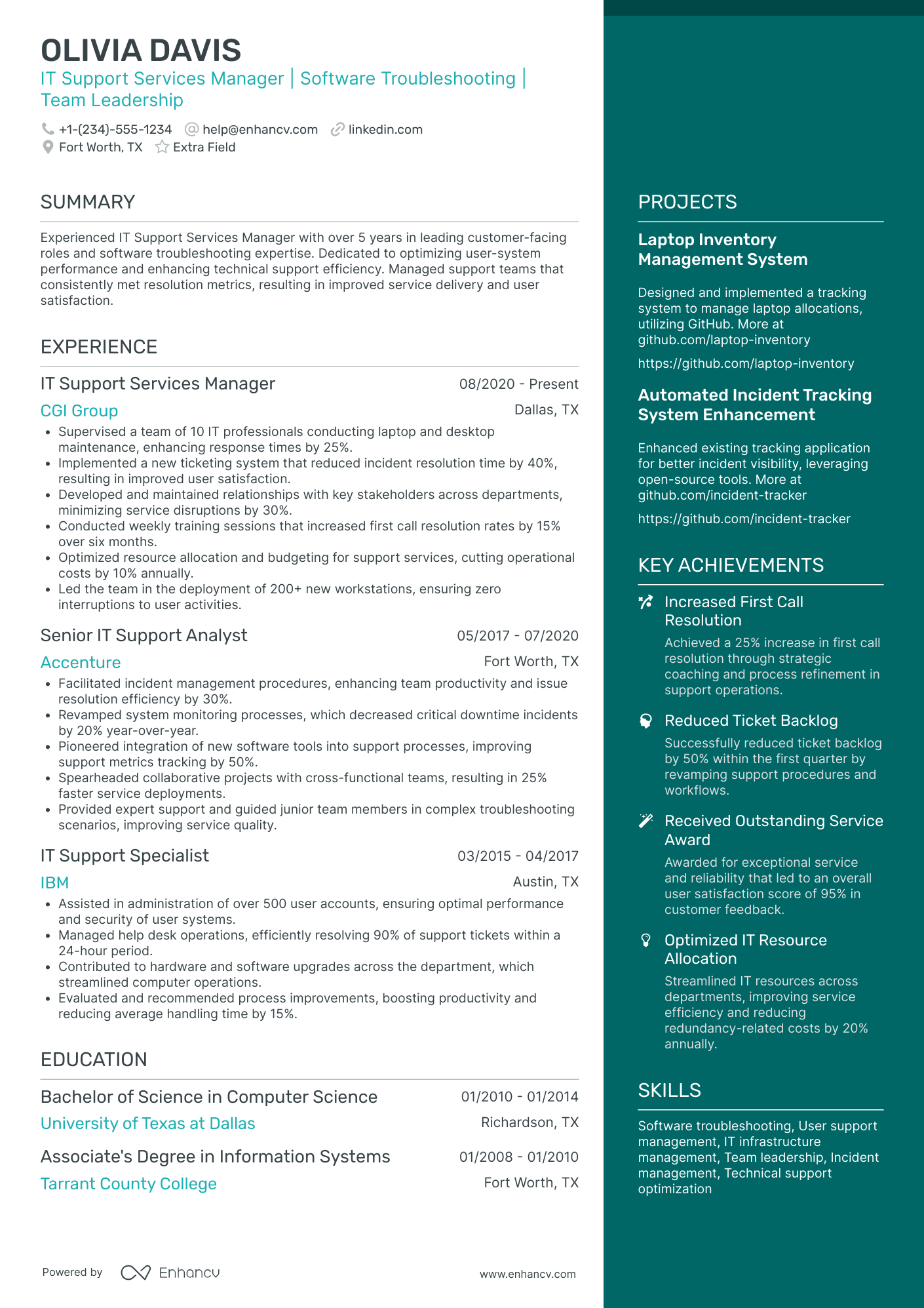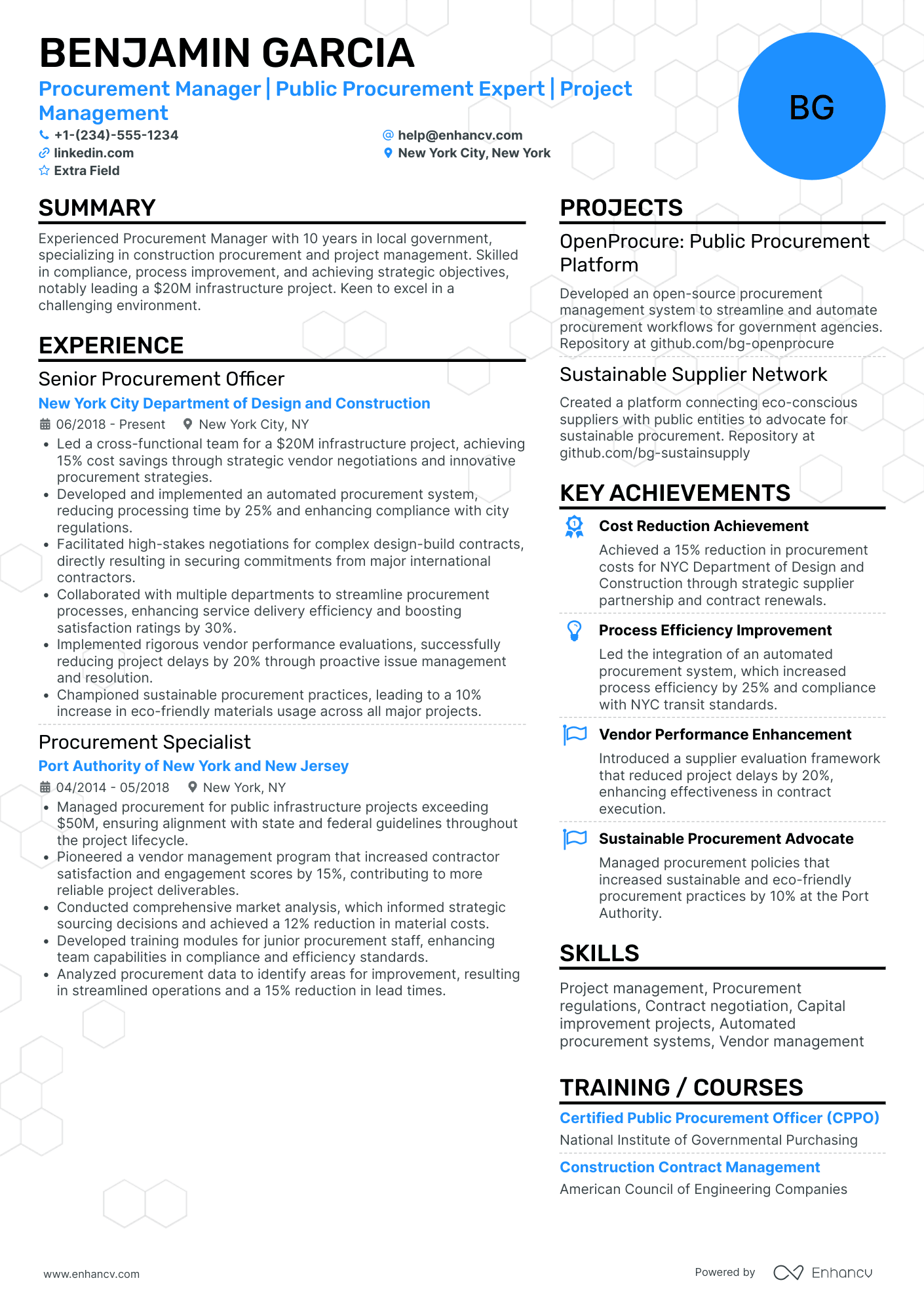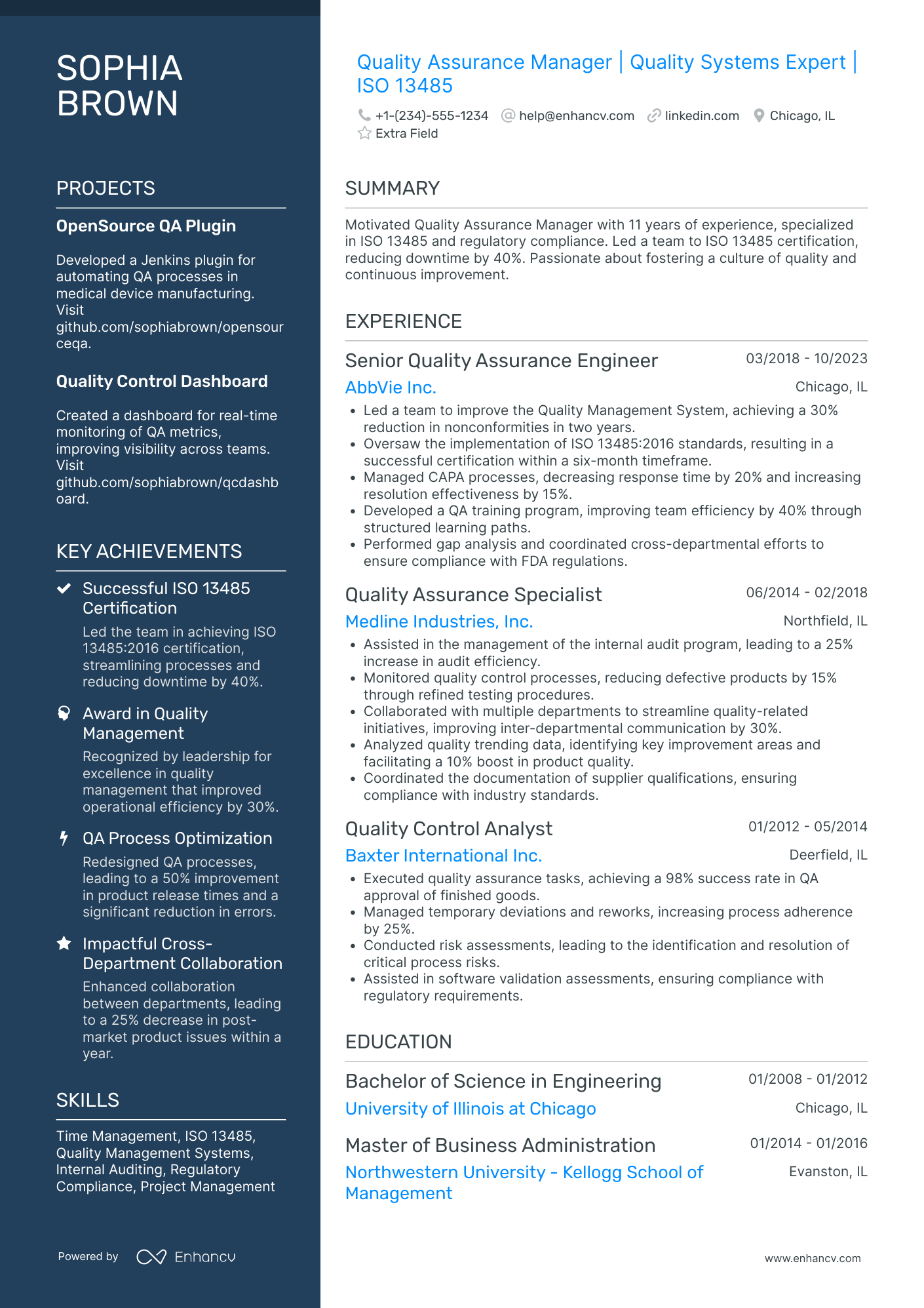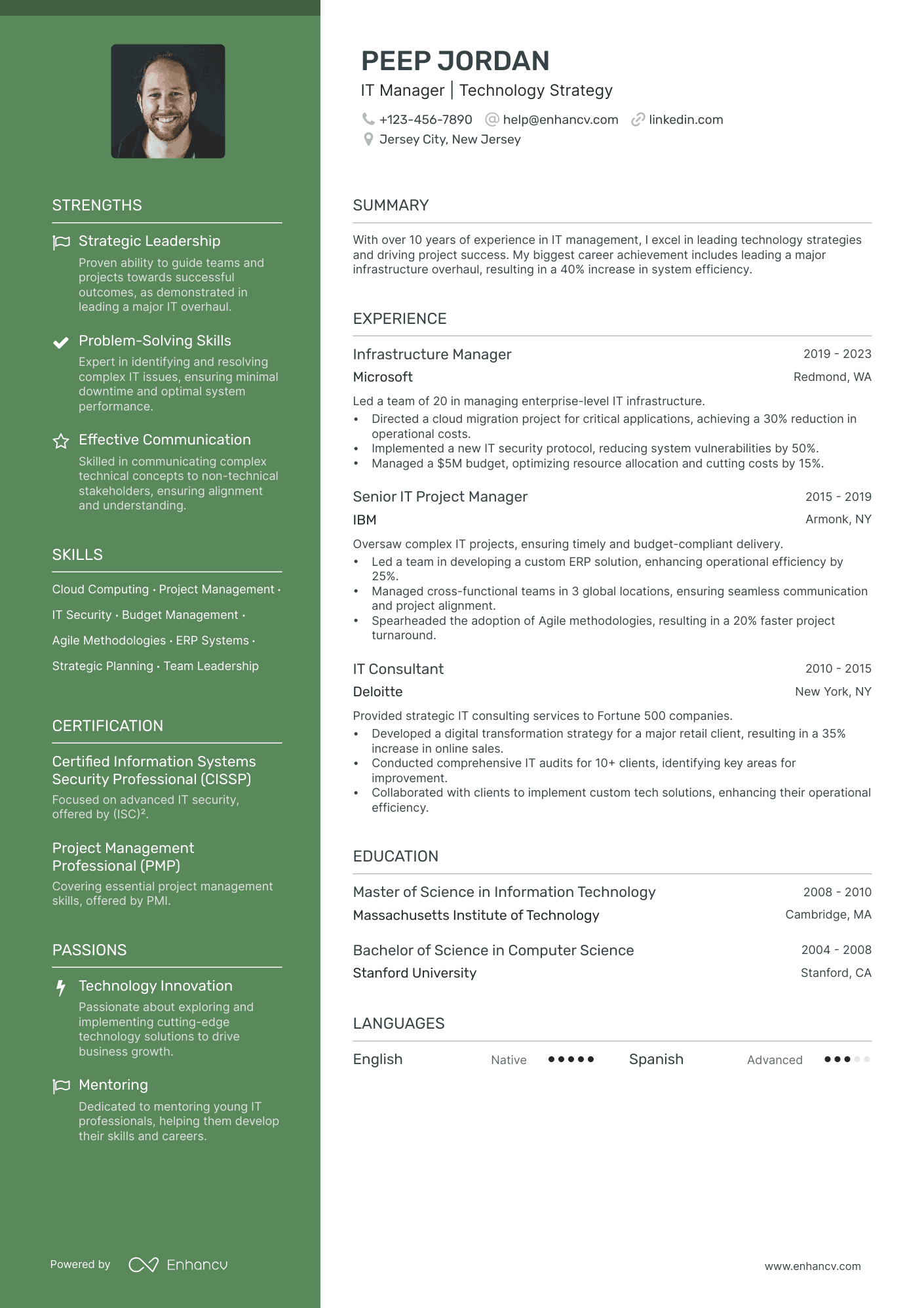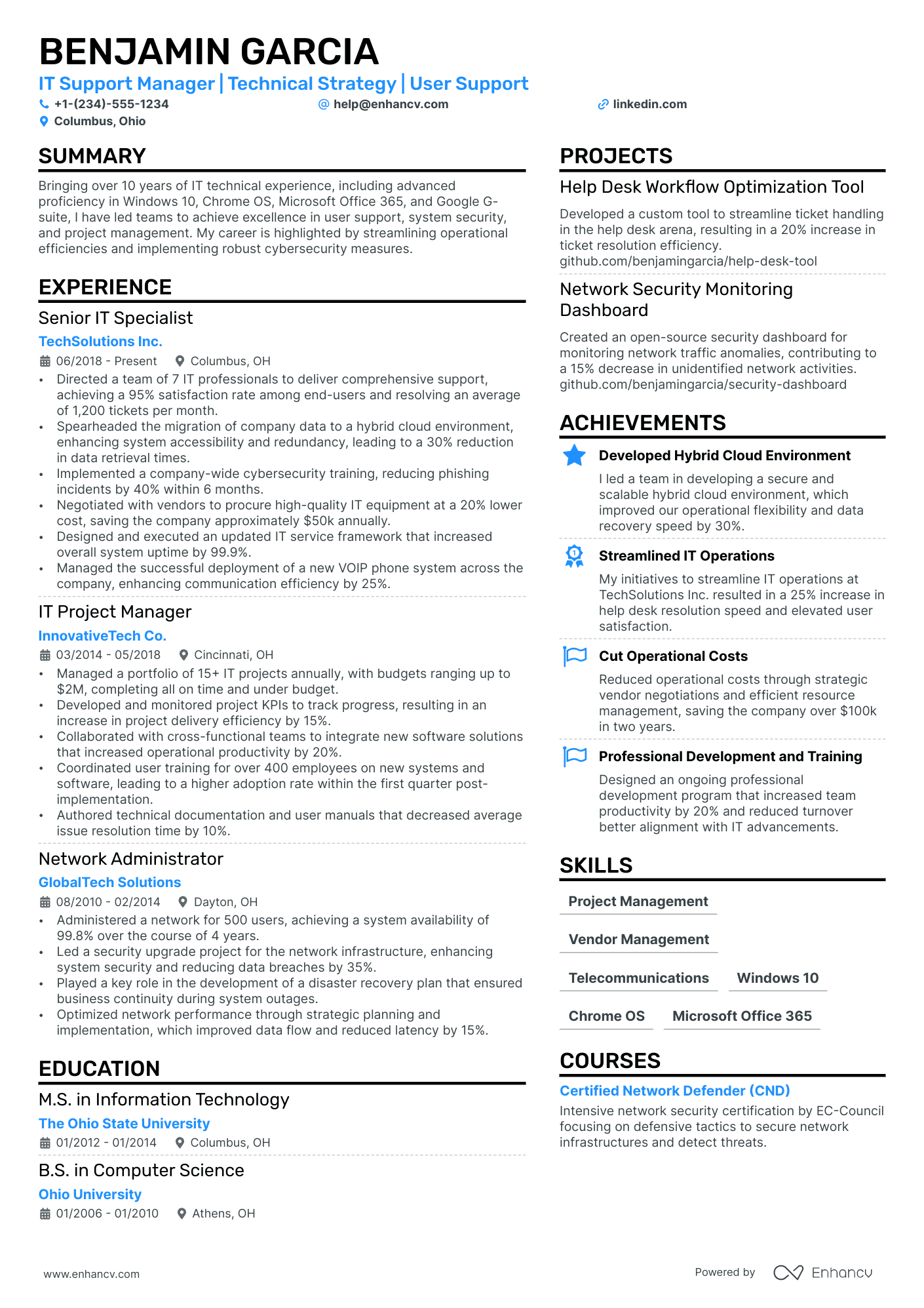You know that it takes much more than being tech-savvy to become an IT manager. You also must prove you’re a strong leader and have enough business acumen to support your team.
But do you know how to show these aspects of your work on your IT manager resume?
We can help you:
- Follow our real IT manager resume sample and use it to build your own.
- Flaunt your social talents, even when discussing technical work.
- Craft an impressive resume, regardless of how much experience you have.
You can also review our other related guides for more writing inspiration:
- Software Architect resume examples
- IT resume examples
- IT Project Manager resume examples
- IT Director resume examples
- Enterprise Architect resume examples
IT manager resume example
Here’s what this applicant does well in their resume:
- Demonstrating commitment to professional development: The resume effectively highlights relevant and highly valued certifications, such as CISSP and PMP.
- Display career growth through a well-structured experience section: Building your way up from an IT Consultant to an Infrastructure Manager is no easy feat. And the quantified achievements on this resume are a testament to that.
- Standing out with a 'Most Proud Of' section: By highlighting accomplishments they are personally proud of, the applicant gives the resume a personal touch. While also boasting about their ability to drive significant organizational changes.
- A tailored skill section that is perfectly aligned with the demands of the IT manager role: By including talents, such as cloud computing and strategic leadership, the applicant emphasizes their multifaceted skill set.
How to format an IT manager resume
As an IT professional, you know the importance of effective communication.
On one side, you have to decipher tech requirements and implement solutions. On the other hand, you have to be able to explain the results of your work to stakeholders.
This is also valid for your resume.
In all likelihood, your resume will be reviewed not only by a recruiter but also by other tech specialists. Or even the CTO.
So, your resume must be both concise and filled with information that will resonate with anyone reviewing your application:
- Opt for the reverse-chronological resume format: Starting with your most recent position, outline all the experiences that make you the perfect candidate to be an IT manager.
- Limit your resume to two pages: Regardless of how long your work history is, don't go back more than 10 years and stay relevant to the demands of the job ad.
- Pick a clean font: Part of being able to communicate effectively is selecting the right design. So, when formatting your resume, choose Lato or Montserrat.
- Link your professional profiles in the resume header: Show some forethought and consideration by sharing both your GitHub in LinkedIn. Senior managers and recruiters will appreciate it.
- Highlight public appearances and personal projects: The best way to showcase your expertise on the spot is through relevant webinars and project presentations..
- Use the PDF file type when saving your resume: Given that your application will probably be shared with several stakeholders, ensure you preserve the formatting of your documents.
Customize your resume for the market – a Canadian format, for example, might vary in structure.
Is your resume good enough?
Drop your resume here or choose a file. PDF & DOCX only. Max 2MB file size.
These steps will help you create a solid foundation for an IT manager resume template. Once your outline is ready, you can delve into the finer details.
First, you must divide your resume in a way that will allow you to shine the spotlight on all the different abilities you have to offer.
Some of these include:
The top sections on an IT manager resume:
- Technical Skills section: Display your ability to coordinate and manage complex systems, as well as your expertise in networking and cloud computing.
- Professional Experience section: Detail the wide scope of IT management duties you’ve tackled by referencing relevant past roles and achievements.
- Certifications and Courses section: Draw special attention to your tech qualifications and credentials to prove you’re up to date on industry trends.
- Project Management section: Demonstrate your experience in leading and successfully delivering IT projects.
- IT Achievements section: Focus on specific accomplishments to highlight your professional impact and tech contributions in previous positions.
What recruiters want to see on your resume:
- Proven leadership in IT projects: Recruiters are looking for evidence of your ability to lead and instruct your team while handling complex technical challenges.
- Technical expertise and training: Relevant certifications (like PMP, ITIL) are crucial to ensure the candidate is equipped with the latest industry knowledge and practices.
- Experience in IT strategy and infrastructure: Hiring managers prioritize candidates who have experience in designing and developing IT strategies and infrastructure because these skills are key when supporting your team as an IT manager.
- Strong problem-solving skills: IT managers often need to quickly address and resolve technical problems, so proving you’re an excellent troubleshooter is essential.
- Emotional intelligence and interpersonal skills: IT managers must be able to navigate intricate conversations while taking into account the level of involvement and tech expertise of various stakeholders.
How to write your IT manager resume experience
The experience section is the resume segment where you detail your work history and list pertinent achievements for every single position you’ve held.
That's why it's the trickiest section to get right.
Especially when it comes to a role that requires you to be a people person with a very strong technical background.
So, before you start building your experience section bear in mind to:
- Match each of the technical demands from the job ad with relevant achievements from your professional work history.
- Cite instances where you've been responsible for any organizational or administrative tasks that have helped support your team.
- Mention cases where your work has positively impacted your employer’s business operations or contributed to achieving their corporate goals.
In essence, your resume has to be the perfect combination of technical expertise, emotional intelligence, and business acumen.
How you balance the three aspects will depend on the seniority of the managerial role you’re aiming at.
The higher the role on the corporate ladder, the more you must focus on the last two points.
So, how to describe management experience on your resume?
- Emphasize your organizational and business administration skills.
- Avoid heavy use of technical jargon or resume buzzwords.
- Be specific when describing projects, but don't go into too many details.
- Always state which tools, platforms, and software you've used to facilitate your work.
- Describe how your contributions reflect on your employer, in general, to show you're always keeping an eye on the bigger picture.
- Include experiences that relate to the company's current business goals.
It may seem that there are too many tips to follow. But at the same time, this also goes to show the significance of tailoring your resume for each available position.
A cookie-cutter IT manager resume won't do.
To illustrate, have a look at the sample below:
- •Delivered many integration and development solutions in 2021 and 2022, which resulted in an YoY revenue increase of $142 million, $267 million, and $84.
- •Mentored and consulted 28+ Junior IT specialists.
- •Increased client satisfaction rate by 76 percent.
In an attempt to concentrate on large-scale results and keep clear of tech slang, Sean has made a few errors. He has:
- Failed to point out that he was, in fact, an IT Assistant Manager. The only clue to his technical expertise can be found in the second bullet. And even there, the information is too vague.
- Shortened the company description to state PaySafe’s main business line. But has omitted to specify which industries the company offers its services to. Hence, Sean missed an opportunity to hint at platforms and tools he is familiar with.
- Used confusing wording, which in turn has jumbled the meaning of the sentence.
- Not to mention what he achieved when mentoring the junior IT specialists. Nor how he increased satisfaction rates in the third bullet.
Data and numbers are crucial. But they mean nothing without context.
So, when describing your achievements, remember to:
- Begin each bullet point with an appropriate resume action verb.
- Provide information about what your goal or challenge was.
- Quantify your results and list the respective data as evidence.
Let’s transform Sean’s experience entry by applying the tips above:
- •Delivered over 36 integration and development solutions in 2022, which resulted in an increase of $493 million in YoY revenue.
- •Mentored and consulted 28+ Junior IT specialists by placing them on projects, which best suited their professional development path.
- •Increased client satisfaction rate by 76% through coordinating on-site maintenance visits and offering hardware and software recommendations.
Now he is sure to expect a callback for an interview with the hiring managers!
How to quantify the impact on your resume
Measuring the significance of your accomplishments is the key to a successful resume.
It proves that you’re not aimlessly completing tasks. You’re mindful of your actions and are aware of the consequences.
Recruiters are looking for goal-oriented candidates with a knack for planning.
So, when you want to communicate the impact on your IT manager resume, consider the following examples:
- Number of team members you’ve managed or mentored to demonstrate the range of your leadership skills and ability to educate.
- Project budgets you’ve been responsible for handling to disclose that you’re fiscally responsible and able to allocate resources appropriately.
- Impact of your work on IT projects to indicate your ability to run business operations efficiently and productively.
- Number of IT infrastructure projects led to emphasize your project management and technical leadership abilities.
- Percentage of reduction in system downtime or processing time to showcase your problem-solving and analytical skills.
- Amount of money saved through cutting costs to stress your adaptability and ability to optimize IT infrastructure.
- Number of teams you collaborated and coordinated with to illustrate your talent for cross-functional teamwork and knowledge of various business areas.
- Number of servers, systems, and networks you’ve managed to highlight the scale and the size of the IT infrastructure you’re able to handle.
- Number of workshops, presentations, and training sessions you’ve conducted to demonstrate your commitment to knowledge sharing and team development.
- Amount of funds you’ve saved your previous employers through the implementation of better hardware and software solutions.
- Number of awards you’ve won for previous employers as a result of your self-starter attitude and ability to go above and beyond on any project you work on.
How do I write an entry-level IT manager resume
We’ve already discussed how to write your experience section if you have plenty of work history to boast about.
But what do you do if you don't have any managerial experience? How do you write an entry-level IT manager resume?
Remember the top three aspects your resume has to display.
At the beginning of this guide, we shared that seasoned managers must show that they have lots of organizational and administration skills.
By contrast, novice IT managers must concentrate on proving they have a strong technical foundation in addition to the soft skills required for the job.
Also, show that you're familiar with various project management frameworks, such as Agile and Scrum.
Here is a quick way to verify that you've included the right information:
- Read the job description very carefully.
- Write down all the mandatory skills and tools.
- Think of examples for each of the corresponding demands in the job ad from your previous positions.
- Don't forget to state exactly how you've used the software and platforms required by the company.
- Make sure to add at least one bullet point that showcases an IT manager skill for each of your previously held positions. Show recruiters how the scope of your duties expanded over the years.
- Consider adding a section for side projects to demonstrate other abilities you haven't had the chance to exhibit yet.
How to list your hard skills and soft skills on your resume
Speaking of abilities, the gradual shift from more hands-on technical work towards social duties becomes more apparent the more you move towards management-level roles.
Hence your IT manager resume must reflect a cherry-picked selection of your top technical and social talents.
Your tech expertise falls under the hard skills category. When it comes to IT management, these include mainly software, tools, and programming languages.
Be careful which hard skills you list because you will get tested on them once you get to the interview stage.
In contrast, your people skills are part of the soft skills category. These are traditionally harder to quantify, but there are ways to do it.
Simply, use the experience section formula of Challenge-Action-Result (CAR):
- Think of occasions where your skills shined through.
- Take into account the impact of your work.
- Try to quantify the outcome of your actions.
- Begin each bullet point entry with an action verb.
- Provide pertinent information about the project or the challenge you had to tackle.
- Describe what were the results of your work.
And that's it!
Just don't forget to use the same wording as used in the job description when referencing your skills. This is a foolproof way to pass Applicant Tracking System (ATS) filters.
Best hard skills for your IT manager resume
- Network Architecture and Administration
- Cloud Computing (AWS, Azure, Google Cloud)
- Cybersecurity and Information Security
- Data Center Management
- IT Project Management
- Database Management (SQL, Oracle)
- Virtualization Technologies (VMware, Hyper-V)
- Enterprise Resource Planning (ERP) Systems
- Business Intelligence and Data Analytics
- Programming Languages (Python, Java, C#)
- System Integration and Deployment
- IT Service Management (ITSM)
- IT Infrastructure Library (ITIL)
- Disaster Recovery and Business Continuity Planning
- DevOps Practices and Tools
- Machine Learning and AI Technologies
- Blockchain Technology
- Internet of Things (IoT) Management
- Mobile Device Management
- Compliance and Regulatory Standards (GDPR, HIPAA)
Best soft skills for your IT manager resume
- Leadership and Team Management
- Strategic Planning and Vision
- Effective Communication
- Problem-Solving and Analytical Thinking
- Decision Making
- Adaptability and Flexibility
- Conflict Resolution
- Time Management and Prioritization
- Emotional Intelligence
- Negotiation Skills
- Customer Service Orientation
- Innovation and Creativity
- Project Management
- Team Building and Motivation
- Stress Management
- Critical Thinking
- Organizational Skills
- Change Management
- Attention to Detail
- Interpersonal Skills
How to list your certifications and education on your resume
The rise of generative AI at the end of 2022 provided a playground for opportunities for every tech-savvy person out there.
Many decided to test how they could optimize their workload by introducing large language models (LLMs) into their work processes.
As a result, LLMs also infiltrated the ranks of IT managers. So much so that AI is among the top trends for IT management for 2025.
While initially, you couldn't boast of having AI skills, apart from showing how you tinker with ChatGPT as a side project, now there are numerous courses ready to teach you the latest LLM hacks.
This proves just how important having a solid tech foundation and continuous learning are.
With this said, regardless of your academic background, you must be able to list your qualifications and credentials properly.
If you have lots of practical experience, include only your bachelor's and masters degrees by:
- Stating the name of your degree and the issuing institution
- Listing the date you graduated or the expected date of degree obtainment
- Mentioning role-related degree projects and achievements you're proud of
Then, address your certifications as these are acquired continually and therefore carry more weight when it comes to tech trends.
But if you're new to IT management or you’re switching from a different industry, add more details about your degrees first.
Such as:
- Provide your GPA, if it's above 3.5 to demonstrate your knowledge about the respective industry or business niche your company is operating in.
- Make sure to name any relevant majors or minors you've completed.
- Detail information about any relevant clubs or associations you are part of.
Don't forget to push the education section near the top of your resume to let hiring managers know that you have the skills and the expertise, despite your work history.
Then share any pertinent certifications you have.
If you're not sure how to include your credentials, we’ve prepared two samples you can use as a reference:
- •Won the JDD-2017 Global Data Challenge hackathon by helping the team with leadership, project management, research, and testing out features.
Best certifications for your IT manager resume
- Project Management Professional (PMP) | Project Management Institute
- Certified Information Systems Security Professional (CISSP) | ISC2
- Certified Information Systems Auditor (CISA) | ISACA
- IT Infrastructure Library (ITIL) Certification | AXELOS
- Microsoft Certified: Azure Solutions Architect Expert | Microsoft
- A+ (Plus) Certification | CompTIA IT Certifications
- CCNA - Training & Certifications | Cisco
How to write your IT manager resume summary or objective
Your resume profile is arguably the second most important segment on your resume because it presents your character through a personal statement.
Resume profiles fall into two categories. Which one you use depends on how much experience you have within the industry.
If you're a seasoned IT professional, craft a resume summary. In no more than 5 or 6 sentences, describe your expertise and why you're the best candidate for the position.
Remember, when listing your key achievements, make sure you align them with your prospective employer’s current goals. Then, finish off your resume summary with a short list of your top abilities.
On the other hand, if you don't have much practical experience, write a resume objective. In terms of outline, it's no different than the resume summary. But its purpose is slightly different.
The goal is to highlight your transferable skills and any role-relevant achievements to demonstrate to hiring managers that you have the right skills for the offered position.
Let’s look at a few examples to illustrate. The first one is a sample resume objective:
Notice how a few mistakes can ruin your chances at an interview.
In this case, Sean has:
- Centered the text too much around himself as a candidate. Thus, he has failed to align his expertise with the company’s current plans.
- Added a laundry list of skills with no pertinent achievements to support his claims
- Not explained how the to-do list of talents is connected with the position. Or any other of the tech skills required for the role.
The candidate needs to customize his resume objective to emphasize that he is:
- Knowledgeable about the company’s business niche
- Aware of the core KPIs within the industry
Like so:
If the company is planning to enhance infrastructure security, recruiters now know that Sean is the perfect candidate.
Moreover, he is also able to translate his other talents in terms that hiring managers will understand. And bosses will appreciate it as this will directly benefit their company in the long run.
Next, review the IT manager resume summary example below:
This sample does well to mention concrete achievements. But, Neiva hasn’t:
- Specified which talents or tools she’s used to accomplish the described outcomes
- Provided numbers and data as evidence of her achievement
- Included information about her management and strategic planning skills
What’s more, the candidate has combined two of her accomplishments in one sentence. Even though they relate to two different companies.
Always make sure to edit your texts to avoid any ambiguity.
On our advice, Neiva revised her resume summary to fix the mistakes. The final version immediately caught the attention of a few hiring managers:
Additional sections for an IT manager resume
It’s difficult to categorize all your experiences and fit them into the standard resume components. As such, sometimes you’ll have to get a bit creative and include custom sections.
Here are some of the extra segments you can add to your resume :
- Role-relevant university clubs, organizations, and professional associations memberships
- Prizes, awards, and recognitions you’ve received over the years
- Other programming and human languages you know, apart from the ones required in the job ad
- Presentations, white papers, and guides you’ve published
- Competitions, hackathons, and tournaments you’ve successfully participated in
But before you make room for these sections, you should review what you’ve already integrated into your resume.
Check if you missed an opportunity to elaborate on a required ability or experience so that you don’t include redundant information.
How to include a side project section on your resume to further highlight your managerial skills
If your IT manager resume still lacks proof of your management and business administration skills, you can always discuss some of the IT projects you’ve done.
What?
Yes, there is a way to emphasize your management abilities through technical projects.
To do this:
- Create a personal project section, like the one in the example below.
- State the name of the project.
- Describe what the project was about in a few words.
- Think of examples that show the impact of your work on the project in general. For example, a reduction in processing time or automation of operations.
- Quantify your impact and list your examples as bullet points.
If you’re struggling to come up with examples, consider the feedback you’ve received from colleagues and clients about your work.
These usually provide valuable insights you can later use when searching for work or asking for a promotion.
- •Completed the project 3 months in advance and within budget by establishing clear initial project requirements, continuous testing, and providing clear feedback to the development team.
- •Facilitated the integration of the system with all major health insurance providers in California.
Key takeaways
In short, to ensure you craft an impeccable IT manager resume, all you have to do is:
- Use the reverse-chronological resume format to outline the scope of your expertise and responsibilities.
- Link to both your GitHub and LinkedIn in the resume header to show consideration to recruiters and other tech managers.
- Emphasize your business acumen and project management skills, if you’re applying for a senior role.
- Highlight your strategic planning and leadership abilities, if you’re aiming for an entry-level IT manager position.
- Remember to quantify your achievements when building your experience section and display a solid technical background.
- Create a balanced mix of your hard and soft skills.
- Illustrate your willingness to learn new IT tools and technologies by sharing relevant certifications.
- Add extra sections to your resume, such as a personal project section, to impress hiring managers with other skills you have to offer.
IT Manager resume examples
By Experience
Senior IT Manager
Junior IT Manager
By Role
